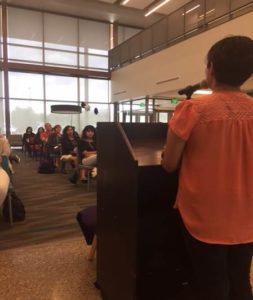Fall 2017
Greetings colleagues. A brief update for the week of December 11-15:
- Although it is very early, we currently have 262 freshmen admitted for Fall 18, this is 16% higher than we were at this time last year. Well done to everyone in SEM and all who helped make this happen.
- On Wednesday, Max, Sylvia, and I traveled to Santa Fe to appear before NMHED. We were seeking the next step in the approval to move forward with the Rodgers project (e.g., approval of architect, etc.) and our various requests were granted. I believe Rodgers will be another great historical renovation on our campus and significantly add to the aesthetic dimension of our grounds. As was the case with the McCaffrey Trolley Building, we will be using Baker + Architectural + Design as our architects on this project.
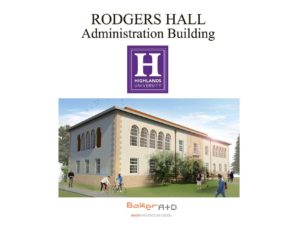
- I was on the road again Thursday…this time to Pojoaque…to discuss the new partnership we have with that district and LANL. I can tell you, there is high enthusiasm for this project all the way around and I am confident that something very good will come of it. Working together, the three partners will attempt to improve STEM performance among kids at the Pojoaque schools and potentially influence the way we prepare science teachers. A photo from that meeting:
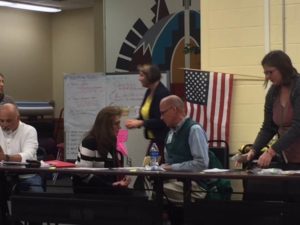
- This was another good week for Advancement. The online art auction ended and that was successful. We also received a donation of art valued at $60,000. Well done.
- Tickets are selling well for the Josh Turner concert on February 3. No one is quite prepared to predict “sellout” at this time, but maybe. A photo of Mr. Turner:
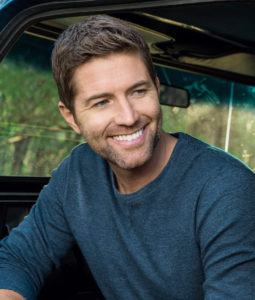
- We have a Board meeting today and I’ll provide an update to the campus afterward.
- HU is out of session next week so this will be my last weekly update for the 2017 calendar year. I’ll continue them once we are back in session in January. Some people celebrate a holiday this time of year…some do not…but holiday or no it is a good time to reflect on the past year and look forward to what might be coming. For me, like most years it was one filled with both sorrow and joys…setbacks and victories. In regard to the former and in the personal domain, the death of my Dad was very difficult, to say the least. He was such a great person…a great dad, husband, grandfather, friend to all he met, and much more. Dad—if you are checking in on me…I am trying to be someone even half as good as you. If I succeed, I’m doing quite well. There were joys as well. Our son, Sam Wolfe, graduated from the University of Missouri School of Law. My daughter, Brook, has taken on even more leadership responsibilities in her little town in Maine. If anyone can get people pulling together toward good and noble goals…she can do it. Our son-in-law, Mark, was elected to the town council in Maine. Joan and I are really proud of our kids and Mark. Our beloved niece, Lily, graduated from Highlands and is doing very well. Professionally, there were also many challenges and also some very good and positive developments. The most significant professional challenge for me (and us) was, of course, addressing the rather long list of HLC issues. I wasn’t really worried about getting them checked off—after all, the HLC tells you exactly what you have to do, it really isn’t rocket science, and there’s plenty of expertise here—but getting all of those things done within the timeframe allowed was of concern. A good mentor to me once said, ““Never let a good crisis go to waste” (I think maybe Winston Churchill?…not sure) and I decided to use the HLC challenges to fire up some strong forward movement on our campus. Because so many of our good colleagues here were so engaged and so committed to the process, I’d say that happened. We have plenty of intellectual and creative firepower here and when that is focused on a common goal, we are bound to succeed. So, I am forecasting a successful HLC outcome for us and then…on to greater things. The overall budget in higher education here in New Mexico was also a special challenge. The higher ed budget was literally zeroed out for a period of time. Money was reinstated, but still…what does it say that society even temporarily and perhaps only symbolically goes on record that something like higher education has no support? Zero. That does not bode well for us. But, there were also many professional victories here at HU. Again, the HLC visit and subsequent discussions I’ve had with the HLC are among them. The team characterized our efforts to address the long laundry list of concerns as “remarkable” and that is nice, but it really isn’t remarkable from my perspective. Again, get enough smart and dedicated people pushing against the same goal and as a good mentor to me once said, you are “doomed to success.” I count the assembly of what I consider a high functioning leadership team to be a great success this year. We have such an excellent Provost in Roxanne Gonzales. She is smart, courageous in the face of adversity, and a good and true colleague. Edward and Terri continue to do well and perform at high levels. Kim was selected as the permanent Dean of Students. She finished her doctorate this year and is doing great things in her division. Max has done a great job keeping us going in the right direction during extremely difficult fiscal times. I have reminded people many times that some of our sister institutions are on fiscal oversight because of big money problems they are experiencing and others have literally downsized faculty and staff to make ends meet. That is to say=—people have lost their jobs. We have not had to take those steps. Laird brings great perspectives to the table. I am particularly pleased with the “HU-Learning Happens Here” program. Sean has proven to be a good and true collaborator in his domain. Ian brings great perspectives to the table and is a clear-eyed and dedicated member of the leadership group. Craig went out of his way to serve as our A.D. during a time of transition. Sylvia is such a strong asset. I count on her a great deal. Caro is such a strength here. So smart. So dedicated. And, of course, Brandon, showed everyone the way to get things done on time and with high quality. In sum, the development and growth of this team has been a highlight for me this year. Teams matter more than individuals. Strong teams produce good outcomes. Other victories…modest forward movement on compensation when most others are not moving at all. We must do more in this area and make certain that all good HU employees move ahead at some point, but still….I am pleased that we’ve done what we’ve done. We had many victories in private giving. The private dollars we received to replace our turf and the naming of the Trolley Building are but two examples (thanks Leveo and Joe and Martha!). I consider the solidarity march in support of our DACA students—and all DACA students—to be a highlight of the year. Our Homecoming was really great this year with many demonstrations of HU pride (thanks Juli and her team!). Launching some new tools—-the Slate CRM, SkyFactor, new onboarding tools and processes, and more was a huge victory as far as I am concerned…and not easy to do. I love the service initiative we are doing (thanks Denise and so many others). I so appreciate the work of our Foundation Board (thanks so much Bill), our Alumni Board (kudos Vince), and the H Club (thanks Syl). But, more than anything else, I love the devotion and commitment I see from staff and faculty…every day… to our noble mission. Those individuals are at the very heart of our work. We have challenges. We are not perfect. We agree sometimes and agree to disagree other times…but, our mission to serve students, to help them become educated human beings and lead lives of high purpose and meaning, to help lift people in or facing poverty out of poverty and help all students, irrespective of their circumstances, land good jobs and have great careers, to make the world a better place by virtue of our teaching, research, and service…that is truly a beautiful thing. It keeps me going every day. It binds us together like nothing else. It transcends the challenges we face in society and any minor or not so minor issues we have internally.
Thank you, my colleagues, for allowing me to share this past year with you.
So, that’s my overall take on the semester. Here’s my holiday message to all: https://vimeo.com/246846014.
Greetings colleagues. A brief update for the week of December 4-8:
- Last Saturday was a busy one beginning with a great birthday celebration for a wonderful son of HU. Afterward , Joan and I drove to Albuquerque to attend the New Mexico Roofing Contractors Association (NMRCA) annual end-of-year gala. The President of that Association, Ms. Tina Cordova, worked with the membership to raise funds to endow a scholarship at HU and at the gala, VP Law and I were presented with a $10,000 check. Tina is a member of our Foundation Board and a true and good soldier for HU. During the meeting, another NMRCA official, Mr. Tim Davis, recognized some apprentices working at a roofing firm and I must say, his comments resonated with me in a powerful way. These apprentices were working so hard to improve their lives and the lives of their families. They are not looking for a handout, but a helping hand up…and when they get one, they take full advantage of it. Sounds like what we do at HU, no? A photo from the event:
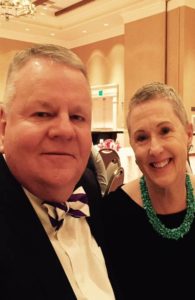
- On Monday I and several HU colleagues met with Dr. John Graham, the Director of MATCH New Mexico. MATCH New Mexico is a nonprofit agency pairing up third grade students with college students. Sometimes high school students are also involved as mentors. We discussed the possibility of establishing a MATCH New Mexico mentoring program here. More on this as things evolve.
- I finished up Monday with an Executive Management Team (EMT) meeting. We normally meet on Tuesdays, but I was out of town on Tuesday. We began the meeting with a review of the Performance Effectiveness Report (PEP), which is a report the Council of University Presidents put together and make available to our state legislators. I want to thank Mr. Buddy Rivera and Ms. Ivy Romero for their contributions to this year’s report. There is lots of information in the PEP and there is good and not so good stories for HU in this year’s version. The good—we remain extremely affordable in a state of affordable options. The number of degrees we produce is on the rise a bit…that’s more good news. We spend less than our peers on administration and more than our peers on instruction. All good there. The not so good—we, like most other institutions in the state, continue to struggle with enrollment. We struggle with our retention rate. We are fairly high in regard to ethnic minority enrollment, but can’t seem to move the needle forward very much. We sit below our peer institutions in regard to employee compensation. I will make sure everyone in the university community can access the complete report. There appears to be a few corrections that need to be made and I’d like to handle those before I send anything out.
- Tuesday was a day in Santa Fe devoted to a Council of University Presidents (CUP) meeting followed by a meeting of the Legislative Finance Committee (LFC). Chancellor Garrey Carruthers, President of the CUP, did a presentation to the LFC and shared the CUP’s positions on several matters. Among others, the CUP is requesting a modest increase in higher ed funding, some changes in the lottery scholarship, and a raise for state higher education employees. It is clear that higher education has some good friends down there. Many of the comments I heard were very encouraging. Most outcomes—economic, health, social, etc,.—-in New Mexico are not great. What is the best hope to improve those outcomes? That question could be debated, of course, but surely…a strong and consistently supported K-16 education system has to be near or at the top of everyone’s list. High performing states find a way to support high functioning K-16 education systems. That’s a fact.
- I held the December “Coffee With The President” on Wednesday afternoon. About 40 people attended. I provided a report on recent campus developments and responded to several questions. I appreciate the fact that people continue to attend these events. I know it takes time away from their work and things pile up while they are gone. Still, there is no ideal upper limit to communication in any organization and attendance at these events does provide another avenue for keeping lines of communication open. Later Wednesday, I had a phone call with some folks from the Association of Governing Boards (AGB). We are trying to arrange a one-day workshop on best practices in university governance. I anticipate we’ll do this sometime in February or March. University governance is rapidly changing and that makes for many challenges and in some cases, tensions. Who “controls” universities these days? Who should? Is the term “control” even relevant right now? What is the rightful role of the state (if we are talking about public schools) in the governance of a university when in many cases, the state is very much a minority partner in the enterprise? What does it mean these days to assert that the faculty “control” the curriculum when, in many cases, the traditional, full time., tenure track or tenured faculty are now in the minority (most faculty these days are contingent)? What is the rightful role of boards? Presidents? I could go on….the bottom line is that this domain is changing and institutions that figure things out about how to effectively move forward will probably do well. That’s why we’re working on this.
- HU, like all NCAA schools, is required to collect data regarding the graduation rates of student athletes. Check out our most recent performance. As you can see, our athletes compare very favorably to the general student population:

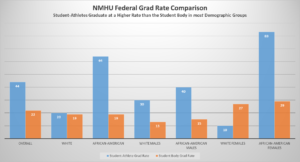
- On Thursday we held the first planning meeting for the institution’s 125th celebration. 125 years….that is a long time for a university to be around, particularly one in the West. Lots of good ideas were offered. One notion that caught some fire was—let’s host a matanza. Apparently, we have a matanza pit on campus and the rumor is that is contains the hollow bones of several former administrators. A grim, but intriguing thought.
- Joan and I opened the University evidence up on Thursday afternoon for the annual Holiday Open House. More than 100 people attended including, I am happy to say, several kids who completed some craft projects and enjoyed popcorn and other treats. A few photos of the event including the HU Student Elves who helped the kids with the craft projects. Also, the noble Piper in her Holiday Finest. She loves any party where careless people drop food on the floor and will pet her if she hangs around and looks pathetic enough:
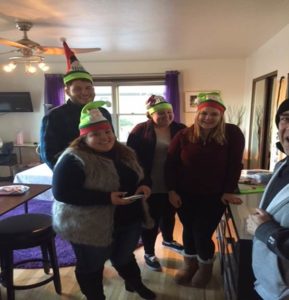
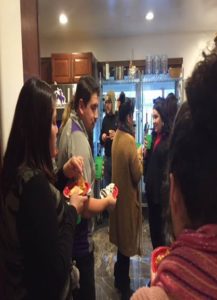
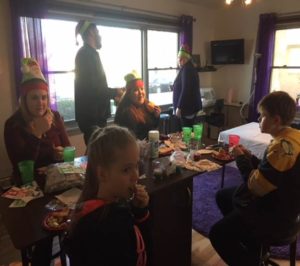
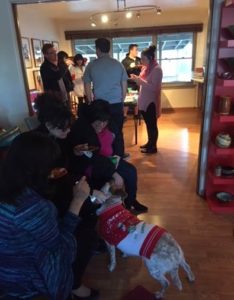
- I am very pleased to announce that, at this point, we anticipate a fall to spring retention rate of about 85%—10 percentage points higher than last year. That is good performance. Apparently, some of our retention efforts are paying off and that bodes well for HU, our students, and our future. WELL DONE to VP Martinez, everyone in SEM, and everyone who helped with this.
- Heard from our man in D.C, Dick Greene, this week who reported that he continues to fight the good fight on behalf of science and rational decision making. He reports it is an uphill battle. He reported that a former Vato player, Kevon, will play this week in front of 70,000 live fans and millions of people watching on TV. The game will be in Capetown, Africa. It will be televised on ESPN3. Dick also reported that he is now working as a liaison to the Pentagon.
- We finalized the contract for our next Arts@HU performer, Josh Turner, and tickets are now available. Of course, there is no charge to HU students at the door. Turner will be here on February 3. Here’s one of his music videos: https://www.youtube.com/watch?v=uFz61X2PQTw&list=PLE6Ie5b51sISgZIL_890A5A9OSgva30QT.
- This week, I was pleased to be able to announce a one-time compensation increase for HU staff. Our staff work tirelessly to support our mission and deserve this action. As I said since I arrived here, whenever I can provide additional support to our employees, I will do so. I was touched to hear from three staff members who thanked the institution for the increase, but also elected to donate it back to the university. My friends, that is commitment. That is dedication. That is so moving given the “all about me” attitudes we see and hear about so much in our society these days. I should also note the extraordinary efforts of two colleagues who worked hard to assist me with the planning and implementation of these compensation increases. Dr. Denise Montoya assured me that it would be possible to include the additional compensation in people’s paychecks in time for the holiday. This is not easy, particularly since HR has recently moved and is getting settled in some new digs. VP Max Baca also worked closely with me to prepare spreadsheets examining various scenarios of compensation adjustments. Without the extra efforts of these two, we could not have accomplished this in time for the holiday break. Thanks to both of them.
- HLC Update—no word about when we’ll appear before the IAC. I hope to make another announcement about our accreditation status soon.
Greetings colleagues. A brief update for the week of November 27-December 1:
- Joan and I travelled to Laramie over the weekend to meet with a former HU faculty member and administrator and watch the team play the University of Wyoming. We met with Dr. Gerald Meyer who served as the Dean here and was instrumental in so many good and positive things at HU. Dr. Meyer is now retired. He was a very well-known chemist here at Highlands and at the University of Wyoming. I heard many HU tales from Dr. Meyer…some of them were pretty interesting and a few of them were very entertaining. Later we watched the HU Cowboys play the Wyoming Cowboys in a non-conference game. We hung with that strong Division 1 team pretty well (83-70). Their small players were about the size of our tall guys so the match ups were tough. A photo of Joan, Dr. Meyer and me and a photo from the game:
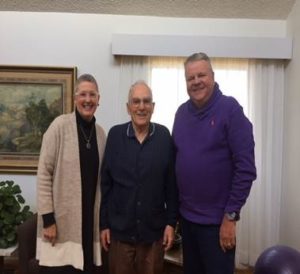
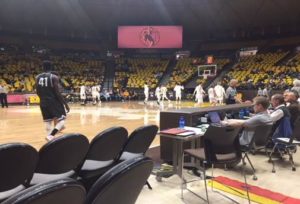
- I began Tuesday with a MainStreet de Las Vegas board meeting. I’ve said it before, but I’ll say it again…MSLV is one of the best things going here in Las Vegas. I am proud to serve on that board. Good things happen in Las Vegas when people pull together, collaborate, and keep the big picture before everything else. I see examples (and some non-examples) of strong collaboration every day and the former can result in very good outcomes and the latter—usually not so much. Like all communities, we would be well served if we worked more collaboratively. MainStreet recently won a grant that will assist another organization here in town with planning some significant project. You’ll soon see something in the Optic about this. I think all communities struggle with collaboration and those challenges are really nothing new. But, as I wrote, when communities can consistently pull together, good outcomes are likely. The successful city campaign to win resources for the Romero fire station and the recent assistance West Las Vegas provided while HU was installing a new turf at Sanchez Stadium are but two examples. There are many more. Want proof that strong collaboration has always been a challenge? This from a 1911 news article—not sure of the author:
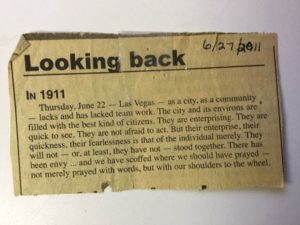
Later Tuesday evening, a group of students decorated some trees at the University Residence. Many cookies met their doom and hot chocolate was consumed in great quantity. Some images of the students and the decorated trees: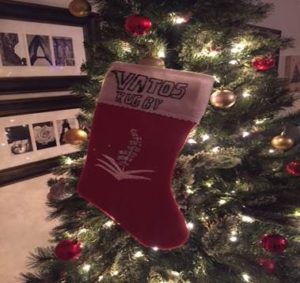
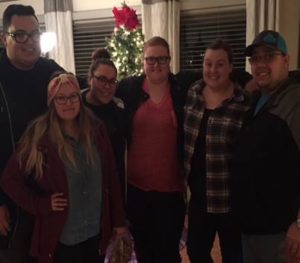
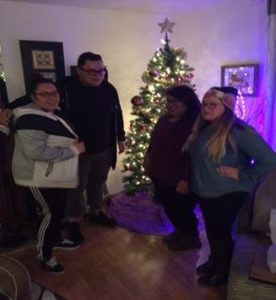
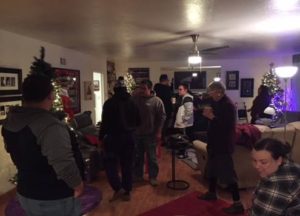
- Last Tuesday was “Giving Tuesday’ and we pushed out a campaign to encourage donors to support HU. Last year—the first time we participated in a Giving Tuesday campaign—we brought in a little under $2,000. This year, our total is $76,202. Well done.
- I’ve been reading quite a bit his week about student focus—-the thinking is that too little attention is paid on focusing students on the things that matter most and will get them to graduation. For example, some schools arrange things so students take one course at a time. Only one. Each class lasts a couple weeks and there are no other academic activities requiring their attention. Just that one class. Cornell College has been doing this kind of thing for some time now (go to: http://www.cornellcollege.edu/one-course-at-a-time/index.shtml). There are other one-course-at-a-time schools as well. Other schools, including an HSI serving students very much like our own, teach classes over only a few week period. Still others teach seven week (not 15 week) classes. Again, the basic idea is that when classes begin and end over a relatively short period (not the normal 14, 15, or 16 week term), there is simply less likelihood that life will intervene and cause a student to get behind or even worse…leave university altogether. There are perhaps a few disciplines where the truncated term approach does not work (composition, for example), but this kind of thing has been studied and there appears to be only a few. Otherwise, students generally learn as much going to class 22 hours per week for a concentrated two weeks as they do attending class 3 hours per week for 15 weeks. In some cases, students prefer shorter classes (https://www.chronicle.com/article/Can-Shorter-Classes-Mean-More/41017) and students earn higher grades in shorter classes without, apparently, sacrificing quality (http://www.economics-finance.org/jefe/econ/Gustafsonpaper.pdf). As Matt Reed recently commented in Inside Higher Ed, “The key is getting the unproductive distractions down to a manageable level.” Some good questions to ponder:
- Should we take a hard look at the traditional 15 week (or thereabouts) semester?
- Might structuring things at HU so our students did not take 4 or 5 classes each term be good for them?
- If we really wanted our students to focus more—to pay attention to the most important things—how would we structure our curriculum?
- Is the two 15 week term idea plus an extended time away during summer really an idea that has outlived usefulness? If so, why do we cling to it so much?
- I received a very well done report this week titled Return On Investment In College Education published by Association of Governing Boards (AGB). I am sure you have heard a great deal lately about the return on investment (ROI) of a college education. Some have recently questioned the ROI. So….what is the ROI like these days? The evidence is clear—the ROI remains very positive. Take a look at the figure below. In 2016, the median after tax income for someone with a bachelor’s degree was $61,400 and the median taxes those people paid was $14,500. Look at those numbers compared to someone with a high school diploma. Striking, no?
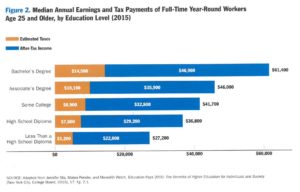
- It will be another busy end of week for me. Basketball games on Friday evening followed on Saturday by a birthday celebration for some great supporters of HU and finally the New Mexico Roofer’s Gala in Albuquerque. A dedicated HU Foundation board member, Ms. Tina Cordova, led a fundraising effort among her associates in the state and Terri Law and I will receive a nice check from that group at the event.
- HLC Update: The next step in our interactions with the HLC is a meeting with the IAC. That group will then make a recommendation to the HLC Board. Our meeting with the IAC will be sometime in March (between the 5-8) or April 23-24. I’ll let everyone know once the meeting is set. The HLC is taking the accreditation process very seriously, which is a good thing. If we are going to establish standards, let’s do it right, let’s set high standards, and let’s hold each other accountable for meeting them. In November, the HLC placed 5 institutions on Notice, 2 on Monitoring, 1 Show Cause, and 2 schools on Probation. That’s just in November. So, as you can see, the HLC is serious about meting standards and equally serious about sanctions.
Best quote I read this week—this from Joseph Aoum, President of Northeastern University and quoted in The Chronicle of Higher Education, “Whenever you have change, there are people who embrace change, people who resist it, and the large majority who wait and see. In higher education, we want to change the world, but we are somewhat reluctant when it comes to changing ourselves. Empower people who want to experiment and innovate. They become the ambassadors. They become the people who will carry the institution.” I should note that the Northeastern model is to get students directly involved in real-world jobs and or unpaid real-world activities as part of their university education…not some add on kind of thing. The “best student lessons”, according to many of our colleagues at Northeastern, are those that happen in messy, but highly engaging real-world environments.
Sam Minner,
Greetings colleagues. An update for the short work week November 20-22:
- Last weekend was busy with a women’s basketball game on Saturday followed by a men’s game followed by the Art Bark auction and finally, the Disney concert. Between me, Joan, and Roxanne, I think someone attended every event. A photo of the Highlands Sweethearts cheering for the team at halftime and a photo of the noble Piper waiting patiently for us to come home from the auction. She so desperately wanted to attend the Art Bark auction, but alas, she did not and she was not happy about it. To me, the look on her face says—I am not happy and will now ignore you for the rest of the evening. We raised about $4500 at the auction. Well done to all who helped make that happen.
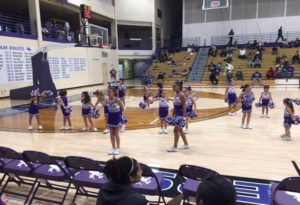

- Last weekend a group of HU students participated in the annual Daniels Fund Ethics Competition at UNM. Teams from numerous states participated and several teams from New Mexico were there as well (e.g., UNM, New Mexico State, Eastern, Western, New Mexico Military Institute, etc.). I am very proud to announce that our team placed second—beat only by UNM—which, I should note, had participated in several prior competitions . Our team was coached by Professors Nick Leger and Melanie Zollner. HU students can compete with the best, no doubt. Don’t let anyone tell you otherwise. A photo of our team: Mr. Stephen Gonzales, Ms. Jessica Eden, Ms. Bethany Brafford, Ms. Rebekah Peoble, and Mr. Ricardo Martinez:
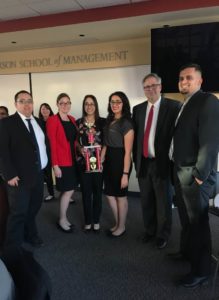
- Joan and I will drive to Laramie this weekend. We will meet with a donor there and then see the Cowboys play the University of Wyoming on Sunday. I should note that we were able to identify all donors from Wyoming—100% of them—including the one I will meet with—almost immediately using our new tool, Raiser’s Edge. Speaking of Advancement, we accrued more than $5,250 this week for various scholarship funds and other initiatives, art which we will auction in the upcoming silent auction (art valued at about $10,500), a significant gift to athletics, and more than $2,000 in gifts from our year-end holiday mail campaign. That $2,000 for the year-end campaign came in on a single day. About $21K in a single week…that is good performance. Well done to the Advancement Team. I am a simple person and for me the formula to improve performance in organizations is: the right personnel + the right tools + the right resources = improved performance. In Advancement, we have the right people, the right tools, and we’ve been able to add some necessary resources and sure enough, we are seeing dividends. I’ve used the same formula in Strategic Enrollment Management. We have great people there, some modern tools (i.e., the Slate product), and some new resources and even though we still must inform students we are on probation with the HLC, things are looking up. To wit, as of yesterday, 2047 students have registered for spring classes. This same time last year, 1802 had registered. If the freshmen who are registered now actually show up in the spring, our retention rate will move to 76%. That’s 4% higher than the spring 2016 cohort. Well done to all who helped make this happen.
- We’re starting the renovation of Stu Clark now…new tile, new bathroom, some new purple carpeting, and some new video displays. That space will be much improved afterward, no doubt. We are using private money to do this.
- Joan held another knitting class on Monday and as always, had great conversations. Here’s an interesting article from the New York Times regarding the health benefits of knitting (https://well.blogs.nytimes.com/2016/01/25/the-health-benefits-of-knitting/).
- This week, we completed another email campaign using the RNL Demand Builder tool. We sent about 15,000 emails to students encouraging their interest in HU. In this week’s message, we emphasized affordability and career outcomes; Here’s the message:
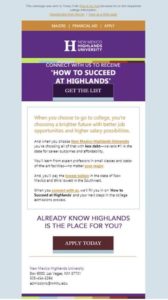
- There was a nice article in the Albuquerque Journal recently about three NMHU students who were awarded fellowships from the Seabury Foundation. This from the Seabury website, “The Seabury Foundation was established in 1947 by Charles Ward and Louise Lovett Seabury. Early interests of the foundation included…educational opportunities for those who could not afford them, conservation of animals and their habitats, ground-breaking medical techniques, health care for the poor, and recreational and character-building opportunities for children. Sixty-eight years later, a larger family, representing an even greater diversity of interests, seeks to respond to the challenges in our society and to an expanding number of requests from worthy organizations.” A photo of our Seabury students: Ms. Elizabeth Lynch, Ms. Jamie Garcia, and Ms. Brittany Hayes:
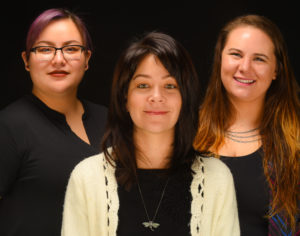
- Giving Tuesday is coming up. Please consider a donation—any amount is appreciated. We’ll push out a reminder and a link to participate. Thanks so much.

- As Thanksgiving approaches, I vividly recall the “graduate student guilt” I experienced while talking over a turkey dinner with my various aunts, uncles, cousins, and other family members I saw maybe once or twice per year. I was in graduate school a very long time while so many of my extended family members were working every day, getting married (in some cases, for the second or third time), buying houses, taking vacations, and starting their lives. This piece in Inside Higher Education really brought back those memories:https://www.insidehighered.com/blogs/gradhacker/navigating-holiday-inquiry. Some of the discussions way back then were pretty uncomfortable. I mean…I grew pretty tired of answering the same questions each year:
- Are you still in school? What grade would that be…18th? Ha. Ha.
- You mean to tell me that even when you’re done with school—if you ever get done—you’ll make less than I do down at the mill?
- Heh…want to see my new Super Sport? Wow…are you still driving that old Impala? That’s sad man.
- Doesn’t Ph.D. really mean piled higher and deeper? Ha. Ha.
- I make stuff for a living. What do you make Sam? Oh yea…you make knowledge. Good luck selling that.
- …and my favorite…You know, you’ll never use most of that stuff you are learning. You learn important things in the world…not in college.
I am well past graduate student guilt now and frankly, I am a little ashamed that it bothered me way back then. I am happy with my career choices and would follow the same path today. I am very thankful for the opportunities my career path has provided. Of course, I am most thankful for personal things…my family, my health, friends, etc.—but I have reflected a bit on what I am most thankful about here—at NMHU—right now. Here’s my list in no specific order:
- I am thankful for the HU staff who go out of their way every day to make this place better.
- I am thankful for Brandon who so selflessly agreed to serve as our HLC liaison and lead assurance argument author.
- I am thankful for the HU faculty who try so hard to help our students achieve their dreams. I could name names, but I fear I’d leave some important names out so I won’t.
- I am thankful that the institution has not succumbed to the “college is just to get a good job” fervor and balances the instrumental goals of a higher education with the traditional and in many ways, more important goals of post-secondary education—to help human beings lead lives of deep purpose and meaning. Can you imagine a world without poetry, novels, music, painting, philosophy, and I could go on and on?
- I am thankful that Brandon stepped up—well, I’ve already mentioned that, but I am doubly thankful for it.
- I am thankful for the work of those leading our voluntary boards—Leveo, Bill, Vince, and Syl—and all members of the Regents, the Foundation Board, the Alumni Board, and the H-Club. These individuals are great soldiers for HU.
- I am thankful for the leadership team I am so privileged to be a part of—Max, Terri, Roxanne, Laird, Edward, Kim, Beth, Sylvia, Sean, Ian, and Caro. They are selfless servant leaders who put HU before self-promotion.
- I am thankful for Caro. As Mr. Gump asserted (or was it Forrest’s mother?), like chocolates, you never know what you will get when you start a new job, but I was so lucky to find her as my new and trusted colleague. Such a hard worker. Such integrity.
- I am thankful to be part of an organization that honors and more than honors….celebrates…human diversity in all of its magnificent forms. Irrespective of ethnicity, social class, linguistic background, citizenship status, sexual orientation, religious beliefs, etc.—all are welcomed at HU.
- I am thankful to our students who often face daunting challenges, but somehow and someway find a path forward.
- I am thankful to our deans—Bill, Cristina, Virginia, and Warren. In so many ways, that’s the toughest job on campus.
- I am thankful that so many of my HU colleagues understand the very real importance of our work, but also maintain a good sense of humor and a positive attitude even when things are tough. I have known some colleagues who basically seem to lurch from one crisis or negative experience to another. That can’t be any fun for them (or others around them) and I avoid them if I can.
- I am thankful to our Faculty Senate—the leaders I’ve known since arriving—Brandon and Ian—who are always so professional and civil…even when we disagree. That is more rare than you might think.
- I am thankful for our Staff Senate and Student Senate. Again, my interactions with those groups have been totally and fully professional.
- I am thankful to our coaches and student athletes. Those who have not been student athletes have no earthly idea how tough that is.
- I am thankful that the university presidents here in New Mexico who work so closely and collaboratively together. That’s rare in my experience.
- I am thankful to have been given the opportunity I have here at HU. I consider it a high honor.
- I am thankful for our alums and many donors who help us in so many ways. Thank you Chairman Sanchez. Thank you Dr. Joe and Martha McCaffrey. Thank you Dr. Bell. Thank you Darwin Ludi. I could go on and fill up quite a few pages.
- I am thankful for the support we have from the residents of the city, the region, and beyond.
- And finally, I thank Dr. Kempner—again, I’ve already done that, but the third time is a charm. Three is an important number in the world. Ask my son, Sam. As I’ve heard some musicians say, “Once is a mistake, twice is an arrangement, and three times—it’s jazz!” True, true.
All in all, I am a pretty thankful guy. I consider myself a lucky person. I hope you can say the same. Happy Thanksgiving
Best quote I read this week—this one about trying to improve retention and graduation rates (at any cost):
“We may get more bang for the buck by helping those who least need it, but that’s not why we’re here. I wouldn’t want to lose sight of the mission in the pursuit of efficiency.” If you’d care to read the whole article, here it is: https://www.insidehighered.com/blogs/confessions-community-college-dean/road-testing-new-paper?utm_source=Inside+Higher+Ed&utm_campaign=df10ecb147-DNU20171121&utm_medium=email&utm_term=0_1fcbc04421-df10ecb147-198622925&mc_cid=df10ecb147&mc_eid=1b6e1fa6ce.
Greetings colleagues. A brief update for the week of November 13-17:
- The final HLC team activity took place last Friday. The team wanted to have a brief chat with former Regent Sandy Turner. Sandy graciously agreed to visit with them over the phone on Friday afternoon. I think that was the last contact the team will probably have with anyone before they prepare their report. The team is now working on their report and I will let the campus know when I receive it. I should also note that I received eleven unsolicited expressions of support from HU faculty, staff, students, and community members about the visit. All were very positive with many expressions of pride in the institution, our mission, and our collective efforts to change lives every day. My personal favorite, “It was great to be able to say what really happens here and what an amazing place this is. I know the HLC was convinced of that!”
- Last Friday and Saturday were very busy, but very good days for HU. I began Friday with an NMHU Foundation Budget Committee meeting in Santa Fe. The committee took a number of actions to further strengthen the Foundation. That meeting was followed by a full Foundation Board meeting from 10:00 a.m. to about 3:00 p.m. The Board heard reports from alumni affairs, governance, nominations, and other committees. I also provided a report on campus happenings. I am really not certain how it came about, but some board members felt NMHU should, at some point, host a mantanza. Pretending to know what that was, I surreptitiously googled it and found to my horror that it referred to a 1932 Salvadoran peasant massacre. OK…the board was planning some terrible thing. Was I somehow in a cult or something? Scrolling down a bit, I found that in New Mexico, a mantanza is basically a pig roast. You dig a hole. You somehow acquire a pig and you roast the darn thing for many hours. Then, dinner is served. In the Midwest, we simply call this a pig roast. In Belize, it is called a jump-up (basically, a big party with roast pig). Here…it is a mantanza. We apparently have a mantanza pit somewhere on campus (who knew and pray tell, what might be in it?) and as I wrote, mantanza fervor somehow took hold at the board meeting. So, at this point, we have some very preliminary plans to have a mantanza…perhaps in conjunction with the rededication of the Stu Clark Building after that renovation is done. Local swine…beware.
Later that same day, Joan, Terri Law, and I had a nice meal with the officers of the H Club. There is high enthusiasm within the H Club these days and a true and sincere spirit of collaboration. Working together, I know we can do great things. There is a shared commitment to do that.
After the H Club dinner it was down to Albuquerque to spend the evening and later participate in the various activities around the All-New Mexican Basketball Tournament at the Pit. Before the game, we hosted a very nice crowd at the tailgating event. It was a very positive vibe and I heard many expressions of pride in HU. A photo from the tailgating activity: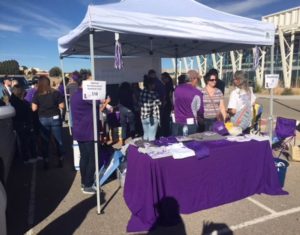
Later that day, HU competed against Western New Mexico. The game was competitive, but I don’t think we ever trailed. It was great to see a W in the first game of the season. Many dedicated HU fans were in attendance.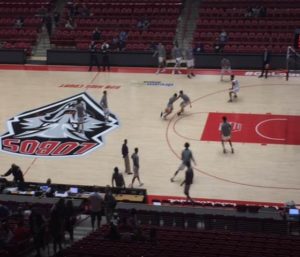
After that, we held a post-game reception and alumni event at the St. Clair Winery and had a great turnout. Our coaches and team members were also there and did a great job circulating and introducing themselves to everyone at the event. Photos of that event: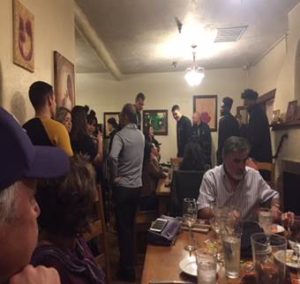
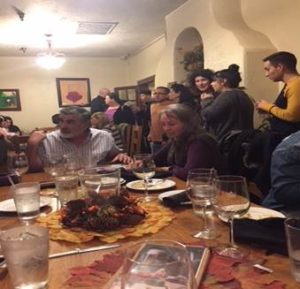
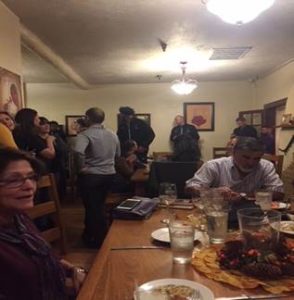
As I wrote, the weekend was a very good one for HU. One exception—two former colleagues of mine drove over from Flagstaff to see the games and their truck was broken into while parked in the lot of an I-40 hotel. Not a pleasant thing, but then again…perhaps required in order to be able to say one truly had the complete Albuquerque experience. The weekend was also busy on campus. On Saturday, we brought Mariachi Reyna de Los Angeles to our campus. I was not able to see them, but I heard it was a stirring performance met with high enthusiasm and much applause. Another event I missed due to being off campus was the campus Veteran’s Day program. By all accounts, it was very moving. We owe our veterans so much and it is just too easy to forget the incredible sacrifices they and their families made and continue to make every day. Our Provost, Roxanne Gonzales, was at that event and read this statement:
“I’m very pleased to announce that President Minner is in support of the establishment of a Veteran’s Support Services Committee to support our active duty, National Guard, Reservist, and veteran Highlands students and their families. The committee will be made up of faculty, students, and key offices to ensure that our veteran students and families receive the support services needed as they complete their degrees. I’m remarkably excited about this committee – Highlands is committed to serve those who have served. Highlands honors all who have served!”
I look forward to getting this done. It is long overdue. Thanks to Roxanne for her leadership to make this happen.
- On Monday, Joan and I had lunch at the SUB. The food was fresh and plentiful and there were a number of options including some vegetarian choices. I spoke with several students, staff, faculty members, and community members about their dining experience and the consensus was very positive. Nothing is more personal than food choices so some individuals made some constructive suggestions, but overall…things were positive. And, for $5.00 for all you care to eat…thee is just no better deal around. I welcomed several community members who were dining on campus. They thanked HU for providing the $5.00 option to anyone interested in dining there.
- Later on Monday, I visited with the student Vatos coach who briefed me on the season thus far. We have beaten every tem except Regis and the coach believes we can beat them next term. The team is doing well and making good academic progress. The Vatos have participated in a number of community fundraising events including a canned food drive, the Buddy Walk for Down Syndrome, and the Beat Diabetes Walk. Also on Monday, I met with the VPs and others to continue the budget hearings. Once again, the conversation was lively and sometimes more, but always professional. We are getting close to finishing those hearings and when we are done, I’ll provide a report and update to the campus.
- Joan held another knitting class on Monday evening. Apparently, her students are making good progress on their various projects.
- On Tuesday, Joan and I had pizza and salad with a group of students at a downtown eatery. We normally have students over to the University Residence for meals, but this time around, we hosted them at J.C.’s Pizza. It is always great to talk with students and hear what’s on their minds. What’s mostly on their minds—getting a good job after graduation.
- On Wednesday morning we held another “Coffee With The President” events in the SUB. About 100 people attended the event and heard me provide an update to the campus in several areas—facilities, personnel, advancement, academic affairs, athletics, and, of course, accreditation. Thanks to all who took time out of their busy schedules to attend. Also on Wednesday, I was able to attend the very end of a student debate regarding immigration. The event was a program held in conjunction with International Education Week. It was really great and I was so proud of the skills and overall deportment of our students. Thanks to everyone who participated, attended, and made it happen. A photo from that event:
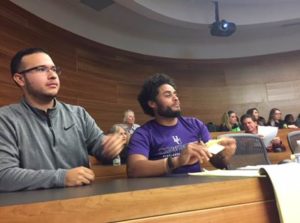
Later on Wednesday, I participated in a long conference call with the Council of University Presidents. We spoke about our collaborative positions on items in preparation for the new legislative session. The focus was on the lottery scholarship, reaction to the recently published LFC report, compensation for staff and faculty, and a few other items. The CUP is really a wonderful group—the best university president’s group I’ve experienced in any state. Sometimes our unified positions win the day. Sometimes not. But, the group truly is collaborative and functions well together.
- We pushed out approximately 15,000 emails to high school seniors this week encouraging them to consider HU. This message (third in a series of five) focused on our affordability and our easy access to outdoor recreation. The tag line was, “Affordability or Outdoor Adventure: You don’t have to pick one.” Last year, we did not send out messages to high school seniors until March or April—really, way too late to make much of a difference. The process we are using now is an RNL product called Demand Builder.
- On Thursday, a very nice group convened at the University Residence to discuss this semester’s “Big Ideas” book, Hillbilly Elegy by J.D. Vance. It was a great discussion—just the kind of thing that I thought would happen all the time when I was in graduate school, but unfortunately, happens way too little in practice. That’s too bad, I think, but when it does occur, it is really nice. Our discussion leader was Dr. Orit Tamir who worked valiantly and mostly successfully to keep the group on track.
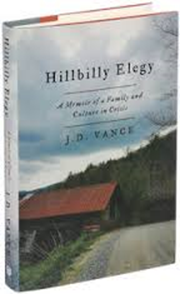
- Please mark your calendars for a special musical event on our campus. The NMHU Singers will perform “Disney: Through Light and Dark” on Saturday, November 18 at 7 p.m. and Sunday, November 19 at 4 pm at Ilfeld Auditorium. Tickets ($5) at the door & free with valid student. ID. Children of all ages are especially welcome at this production as they’ll love seeing Snow White, Moana, Aladdin, Ursula and Cruella De Vil on stage! After opening with the lively “Be our Guest” (The Beauty and the Beast), you’ll be treated to delightful solos including Lynette Melendrez’s cynical “Mother Knows Best” (Tangled), Miranda Andrego’s lyrical “A Dream is a Wish Your Heart Makes” (Cinderella), and Joe Thompson’s powerful “Be Prepared” (The Lion King.) You’ll also enjoy the haunting harmonies in “Colors of the Wind” (Pocahontas) and “Under the Sea” (The Little Mermaid) using fantastical puppets created by Eli Babe, Nicolas Evans, Yareli Romero and Aaron Williams. “The Circle of Life” (The Lion King) is a fitting grand finale for HU Singers. We are so fortunate to be able to hear musicals, a cappella, jazz and classical music right here in Las Vegas.
- Congratulations to one of our top student-athletes, Mr. Terrence Jackson Jr. This week he was named the RMAC Defensive Freshmen of the Year. Mr. Jackson is the FIRST Cowboy football player to receive an RMAC Freshmen of the Year honor and the first major post-season honoree from HU since 2014. A photo of Mr. Jackson. Well done!
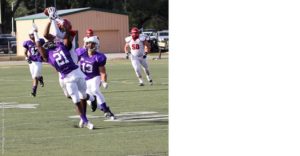
- Kudos to our good colleagues—these came to my attention this week—I am sure there are others who are doing good scholarship and service—Dr. P.J. Sedillo, recently attended the 64th Annual National Association for the Gifted Conference in North Carolina and was interviewed by a local paper there. His interview also appeared on a local news channel in North Carolina. Dr. Sedillo also recently published a book, , Solidarity Through Pride, and it is doing quite well. P.J. is clearly a very prolific scholar. Here’s the newspaper article:http://www.charlotteobserver.com/news/local/education/article183748461.html#ampshare=http://www.charlotteobserver.com/news/local/education/article183748461.html. Thank you P.J. for representing HU so well. Adjunct Professor Yolanda Montoya-Cordova, was recently named to the Albuquerque School Board to complete the term of Analee Maestas. I know that Yolanda will serve with high distinction and integrity. We all thank her for her selfless service to the district and the children and families of Albuquerque.
- On Saturday, I’ll serve as the guest auctioneer at this year’s Art Bark—a fundraiser for the local shelter. I’ll be auctioning off some great art from several new Mexico artists. The event is from 4:00-7:00 p.m. in Kennedy. Come on out and get a few gifts for the holidays or pieces to hang on your wall.

My favorite quote from this week:
“Today’s students have a slow life strategy. They are simply taking longer to grow up.” Jean Twenge, Professor of Psychology, San Diego State University. Quoted from the article Taking Longer to Grow Up in The Chronicle Review, page A7.
Greetings colleagues. A brief update for the week of November 6-10:
- Our HLC visitors were with us last Friday and a few days this week. To say it was a whirlwind visit is an understatement. But, I also think it is an understatement to say that the visit was positive. It was more than that. I did not write down or record any comments our visitors made, but here are a few of them that come close to what was actually said. If I have words or phrases in quotes, that means one of our guests actually used those words or phrases:
- …the “best” campus visit I was ever on…
- …the campus is unified like few I’ve seen…
- …the whole visit was superior in every way…
- …an “incredible” transformation in a short period of time…”remarkable”…
- a “case study” for campus turnarounds…
The participation across the campus and Centers was really great. Between 325-375 students, including Center students, participated in the Student Forum. About 100 faculty attended the faculty forum. Twenty-three individuals, including at least one who flew in from out-of-state, participated in the community forum. About 220 staff members participated in the Staff Forum. This level of engagement was also noted by the HLC examiners and they all congratulated us for mobilizing the campus so effectively. I thank the faculty for their support. I thank the staff. I thank the administrative team. I thank the many friends of HU who helped on this in some way. And, of course, I thank Dr. Kempner for his yeoman efforts to keep us on track and demonstrate one of the highest levels of selfless commitment I have ever seen. The next step is a meeting with IAC in Chicago and then final board action. I am supremely confident. A photo from the student forum: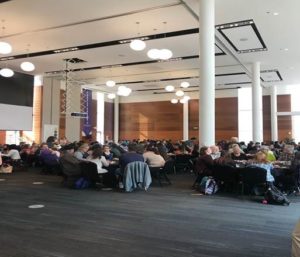
- Joan held a nice class on Monday evening for students interested in learning how to knit. She had some beginners and some experienced students and apparently, everyone made progress toward whatever project they were working on. She’ll be holding these classes every Monday evening so people can potentially complete a gift to give someone for the holidays. If you missed the class last Monday, just show up next Monday and she will catch you up.
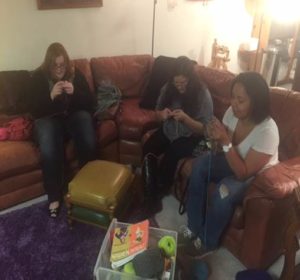
- I met with our liaison to Los Alamos on Tuesday and she indicated to me that the Lab would be funding another project here at Highlands—the Drone Rodeo Project. Basically, Mr. Mariano Ulibarri and others will be working with students to build and use drones in “rodeo” type events. The culmination of the project will be a public demonstration of drone rodeo activities. It should be a lot of fun. More on this later.
- It was a dark and stormy night. I think this language is called “purple prose” so it is perhaps appropriate that we use it here at Highlands. Technically, it was a dark and rainy and snowy night on Tuesday when I joined a very nice and committed group of students, staff member, faculty members, and administrators on a safety walk around campus. We noted several problem areas and issues. The Student Senate will prepare a report and some recommendations and I’ll certainly give them serious consideration as we move forward. It was a really miserable night weather-wise, but at the same time, it was so affirming to see so many students (and others) taking the time to make HU better. Some photos of the intrepid group participating in the Safety Walk:
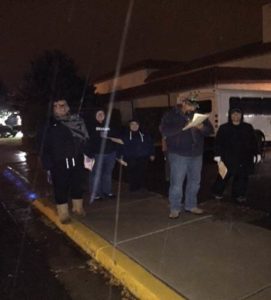
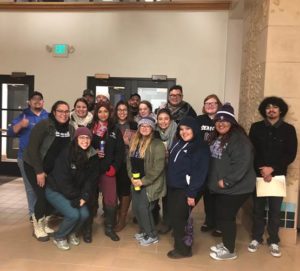
- Please consider participating in the Giving Tuesday Campaign, which will be on Tuesday, November 28th. You’ll be receiving some messages about how to do this. At this point, we are featuring two projects you can help support—The Rainforest Adventure project and the New Mexico Painter’s Exhibition Project.

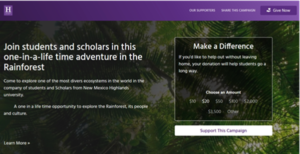
- This weekend will be a busy one. The Mariachi Reyna De Los Angeles will perform in Ilfeld on Saturday at 7:30. Students will pay nothing at the door for this Arts@HU event. General admission is $15.00. Our Cowboys football team will play their final game of the season at Adams State. You can watch the streamed game on the RMAC website. Our women’s basketball team plays at 6:00 p.m. at Rogers State, volleyball plays in Durango, and our wrestling team competes as well. The men’s basketball team plays at The Pit on Saturday and Sunday in an all New Mexico tournament. There are several other events taking place this weekend. Nothing to do on campus or in Las Vegas? Not true. Not true. The Mariachi Reyna De Los Angeles troupe and a nice story about the men’s basketball opener by Margaret McKinney:
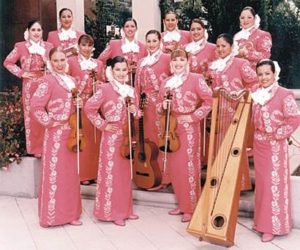
Tailgating at Cowboys Basketball Season Opener
Margaret McKinney/University Relations
Las Vegas, N.M. – The Highlands University Cowboys are playing in the New Mexico Classic Basketball Series Nov. 11 – 12 with the university’s Alumni Office sponsoring a tailgate event and other festivities. The tailgating Nov. 11 will be from 1 – 3 p.m. at the University of New Mexico’s Dreamstyle Basketball Arena in Albuquerque also known as “The Pit.” The Cowboys play Western New Mexico University at 3 p.m. “Fans who purchase the special Cowboy Classic Package for $25 will receive complimentary food at tailgate,” said Juli Salman, Highlands alumni director. “They will also be given a New Mexico Classic event t-shirt and alumni gift.” Fans attending the tailgate who have not purchased the Cowboy Classic Package will have the opportunity to purchase food and a New Mexico Classic event T-shirt. Highlands athletic merchandise will also be available for purchase. Following the Nov. 11 game, Highlands fans are invited to attend a postgame celebration at St. Clair Winery & Bistro at 7 p.m. at 901 Rio Grande Blvd. N.W., Albuquerque. Appetizers and soft drinks will be served. Fans who purchased a Cowboy Classic Package will be treated to a complimentary glass of wine. “Highlands fans will also have the chance to meet the Cowboy basketball coaches and players at St. Clair,” Salman said. “This New Mexico Classic Basketball Series is an exciting chance to showcase Cowboy basketball to a larger audience as well as play in a premier venue.” On Nov. 12, the Cowboys play Eastern New Mexico University at 5 p.m. Order the Cowboy Classic Package or individual game tickets for $10 from the Highlands Alumni Office at (505) 454-3248 or email jesalman@nmhu.edu Tickets may also be purchased from UNM in person at the Dreamstyle Arena or online at unmtickets.com.
- On Thursday, the Executive Management Team held the first of several budget hearings. Each VP or other member of the team presented her or his budget priorities and others around the table asked questions and asked for clarifications. Budgeting against our Strategic Plan like this is one way to move toward excellence. I very much appreciated the candor and tone of the meeting—people asked good and hard questions. Another budget hearing meeting is scheduled for next week.
- I recently met with Mer. Regis Pecos, former Governor of the Cochiti Pueblo and current Co-Director of the Leadership Institute at the Santa Fe Indian School, and he expressed interest in a partnership with HU to devise some special programs focusing on the needs of our pueblos and tribes. Our partners would be the All Pueblo Council of Governors. I recently wrote Mr. Paul Torres, the Chair of the All Pueblo Council, and affirmed our commitment to this concept. More on this later, but I could be a very significant initiative for HU.
- I will be out of the office on Friday to attend the NMHU Foundation Board meeting followed by a reception for the H Club. Both meetings will be in Santa Fe. Saturday will be devoted to the basketball tournament in Albuquerque followed by a post-game reception for those attending the game.
- I had some good discussions with our HLC visitors about remedial education. So many researchers are looking at remediation in colleges and universities and the conclusions are pretty clear. The old approach—take students where you find them and somehow build up their reading and math abilities until they can actually complete a college level class—simply does not work very well. This approach has often been called a “bridge to nowhere” for college students. It is very difficult to get someone’s skills up very quickly in such a model and in many cases, students just give up. Take a semester or two of “remedial” classes that don’t really count for anything—in order to take the real classes—well, students just don’t do it. They drop out. Other issues…not many university teachers really know how to teach these classes (go to: http://hechingerreport.org/who-helps-those-who-need-help-most/) and remedial programs are very costly (go to: https://www.washingtonpost.com/news/grade-point/wp/2016/04/06/remedial-classes-have-become-a-hidden-cost-of-college/?utm_term=.6ce795fd4e9d).
- The Big Ideas Reading Group will meet next Thursday at 5:30 at the University Residence. This term, we read Hillbilly Elegy by J.D. Vance. This book has been on the New York Times Bestsellers List for many months and has sparked many conversations around the nation about class, race, and how the contemporary economy has and continues to impact Americans in very different ways.

An interesting review of the book from the Boston Review: http://bostonreview.net/race-politics/elizabeth-catte-mythical-whiteness-trump-country. Given the popularity of this book, lots of other reviews are on the web.
- We’ll receive the report from the HLC team in about a month. I’ll let the campus know how it reads.
Greetings colleagues. A brief update for the week of October 30-November 3:
- I am very pleased to announce that Baker Architecture and Design recently won the top design award from the American Institute of Architects for their work on the McCaffrey Historic Trolley Building. Also, well done to Franken Construction for their work on the project. I was pleased that Dr. Joe and Ms. Martha McCaffrey were able to attend the event as well as Sylvia and Max Baca. I should also note that at the Board meeting last Friday, the Baker Architecture and Design team presented the program and some renderings of the Rodgers Building project. This will also be a great space on our campus and return Rodgers to former glory. The renovated structure will house a board room, a classroom, a Heritage Reading Room, and some offices. Photos of the AIA award, the HU contingent accepting the award, and a rendering of the renovated Rodgers Building:
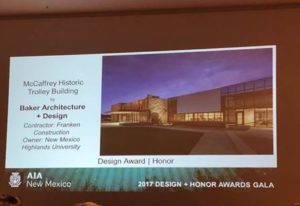
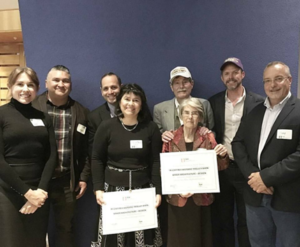
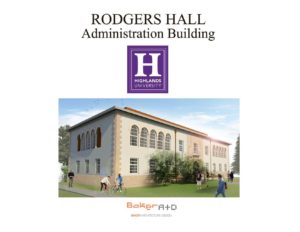
I should also note that process for moving people out of Rodgers to make way for the renovation will soon be underway. The Business Office will be moving on Thursday, December 14 and 15. Other offices and people will be moving in a structured and orderly manner thanks to the careful planning by our Facilities Department.
- NMHU was well represented at the recent HACU conference in San Diego. John Ramon Vigil, Natasha Lujan, Karla Espinoza, and Katelyn Flores attended the conference and participated in a variety of sessions. They also learned about some internship opportunities. A photo from the conference and…the future leaders NMHU helped in their what will no doubt be illustrious careers:
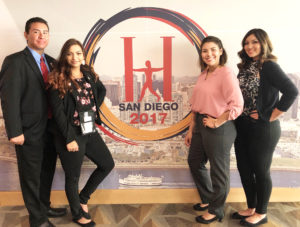
- We continue to push out strong recruitment messages after working closely with our RNL partners and employing our Slate CRM product. Here’s a message we are now pushing out to 15,000 high school seniors. Using modern analytical methods, we believe these students might be particularly interested in HU.
MAJORS | FINANCIAL AID | APPLY

Our students consistently rank New Mexico Highlands University #1 in the state for student satisfaction.
Why?
Because they loved learning in state-of-the-art media studios, science labs, and other facilities.
Because in small classes, they got one-on-one attention from highly qualified professors.
Because they found their calling in one of our 50+ academic programs.
And because they graduated with more job opportunities, higher salary possibilities, and less debt. (Highlands ranks #1 in the state for career outcomes and affordability.)
We think you’ll love it here, too. But find out for yourself—connect with us today to receive our ‘How to Succeed at Highlands’ list.
We also continue to develop a variety of other hard copy and electronic recruitment materials. Here’s a sampling of some e-magazines, a view book, and some materials for parents.
Emag 1:
https://spark.adobe.com/page/XFBLbXIgwzqcA/
or
Emag 2:
https://spark.adobe.com/page/uS4LFDQpYzgvr/
or
Emag 3:
https://spark.adobe.com/page/wUMvIaDGp9jkS/
or
Viewbook:
Parent Guide:
https://spark.adobe.com/page/1GBvkZAlraIJw/
or
- When it comes to solving problems, the first and most important step is always to make certain you are trying to solve the right problem. To wit—is college tuition too high in New Mexico or…do we really have another problem? Check out my latest op ed that appeared in the Albuquerque Journal this week: https://www.abqjournal.com/1086779/states-real-issue-is-weak-economy.html.
- Many of you have heard about or been directly involved in the competition our community has been in to win some dollars to finish the renovation of the Romero Fire House. We are one of the winners. I am very pleased that HU played some small role in this. The official notification:
Dear Partners in Preservation Participants,
On behalf of the National Trust for Historic Preservation, Main Street America, and our partners at American Express, National Geographic, and Delta Airlines, we want to be the first to let you know that the votes have been tallied and that you are among the groups below that will receive full funding through Partners in Preservation: Main Streets!
Parker Hall and the John Trower Building in Germantown, PA – $150,000
Vintage Neon Sign Park in Casa Grande, AZ – $144,000
Formosa Café in West Hollywood, CA – $150,000
The Lyric Theater in Valley Junction, IA – $150,000
The Carolina Theatre in Greensboro, NC – $150,000
- Romero Hose and Fire Building in Las Vegas, NM – $150,000
The Alabama Theatre in Birmingham, AL – $120,000
The Woodward Theater in Cincinnati, OH – $150,000
Ivers Square in Cape Girardeau, MO – $127,650
McKinney Performing Arts Center in McKinney, TX – $150,000
Two communities – Cincinnati and Germantown – will each receive special $10,000 grants for winning the “most improved” voting challenges posed during the campaign. Additionally, Salt Lake City – which came in eleventh place – will receive a grant in the amount $50,000, thus rounding out the funding available through the 2017 Partners in Preservation program. The #VoteYourMainStreet campaign received over 920,000 votes, reflecting a broad level of support for Main Street revitalization projects across the country. We are delighted to have had this opportunity to commemorate the places that matter to our national story and to raise awareness of the work being done across the country to revitalize Main Streets. The enthusiasm generated by the 25 participating Main Street programs, districts, and communities is a testament to how beloved these places are. In the coming weeks, representatives from the National Trust’s grants department will be in touch regarding next steps. As the campaign comes to an end, we would like to congratulate all of our participants and thank you for your hard work to get out the vote. And a special thanks for your dedication and commitment – each and every day – to keeping our diverse history alive and local economies thriving.
Sincerely,
Stephanie K. Meeks Patrice Frey
President President and CEO
National Trust for Historic Preservation National Main Street Center
- NMHU will be collaborating with LANL and the Pojoaque Valley School District to improve STEM education and more powerfully prepare teachers to teach STEM disciplines. This is a wonderful opportunity for our teacher education program and other programs and I am so pleased to be part of this exciting initiative. The press release with a few more details:
Los Alamos National Laboratory’s Math and Science Academy has selected Pojoaque Valley School District as the partnership school for its new teacher education program.
“The aim of the Partnership School initiative is to develop a model for elementary education where pre-service teachers, in-service teachers and principals have opportunities to continually improve their teaching practices,” said Lorenzo Gonzales, education specialist with the academy. New Mexico Highlands University has been selected as the higher education partner for the program, which marks an expansion of the teacher professional development work the Math and Science Academy has carried out in northern New Mexico for 16 years. Pre-service teachers studying at Highlands will complete their required classroom experience at Pojoaque Valley Schools, while the educators currently teaching there will work with the academy to learn best-practice approaches to math and science education. “I am pleased that the Pojoaque Valley School District was selected as the partnership school,” said Melville Morgan, superintendent of Pojoaque Valley Schools. “The innovative opportunity to partner with Los Alamos National Laboratory and New Mexico Highlands University will help us to further develop the capacity of our teachers and leaders, for the benefit of our students. This is an exciting time for our community.”
The first step in this initiative has already taken place, with Pojoaque Valley Middle School teachers attending the Math and Science Academy’s recent Ir-Rational Number Institute held at Northern New Mexico College. “New Mexico Highlands University is proud to have been selected as the higher education institution partner for this new Partnership School initiative. The opportunity to work with the Pojoaque Valley School District and Los Alamos National Laboratory to enhance the education of pre-service and in-service teachers in a school setting will ensure that our teachers are prepared to go into classrooms ready to meet the needs of our students.” said Sam Minner, president of New Mexico Highlands University. “STEM education is crucial to the future of the region and the future of Los Alamos National Laboratory, and we are delighted we can collaborate with our K-12 and higher education partners to bring a groundbreaking model of teacher professional development to New Mexico,” said Kathy Keith, director of the Laboratory’s Community Partnerships Office.
Los Alamos National Laboratory, a multidisciplinary research institution engaged in strategic science on behalf of national security, is operated by Los Alamos National Security, LLC, a team composed of Bechtel National, the University of California, BWX Technologies, Inc. and URS Corporation for the Department of Energy’s National Nuclear Security Administration. Los Alamos enhances national security by ensuring the safety and reliability of the U.S. nuclear stockpile, developing technologies to reduce threats from weapons of mass destruction and solving problems related to energy, environment, infrastructure, health and global security
- Our good colleague Dick Greene continues to represent HU well in Washington D.C. Here’s a link to some of his latest work. This research was also was mentioned in Time Magazine, The Guardian, German Public Radio, BBC World Interviews, and many other outlets (https://bottomlineinc.com/health/brain-health/walk-this-way-to-a-better-brain).
- Joan is organizing her “learn to knit” group again this year. If any student, staff member, or faculty members wants to learn to knit…she can teach you. Contact Dr. Kim Blea for more details. Knitting supplies and some light refreshment will be provided to all knitting students.
- Some of our teams practiced on the new Sanchez Field this week. The project is now done and our football team will play on the field this weekend. Well done to all who helped make this happen. And, of course, many thanks to the Sanchez family for their most generous gift to NMHU.
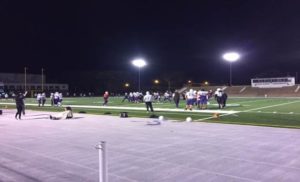
- I spent Monday and Tuesday this week in Alamosa at the Fall RMAC meeting. The presidents and chancellors along with ADs and others routinely attend this meeting. We discussed a variety of issues including concussion lawsuits already filed against some athletic conferences (not the RMAC, at least at this point), sexual harassment policies and procedures, and what various campuses are doing to improve the retention and graduation rates among athletes. On Tuesday morning in Alamosa, I experienced the first major snowfall of the season. Thankfully, everything melted before my drive home.
- On Wednesday, Joan and I welcomed the Ballen Scholar, Ms. Diane Seuss, to the University Residence for a welcome reception. About 25 faculty, staff, and administrators joined us for the very nice event. Many thanks to Drs. Lauren Fath and Tyler Mills for leading the effort to bring Ms. Seuss to our campus.
- On Thursday, I visited the Career Fair in the SUB. What a great turnout of students and employers. The event was very well organized with a nice positive vibe. Many thanks to Ron Garcia for organizing such a great event. A photo from the Career Fair:
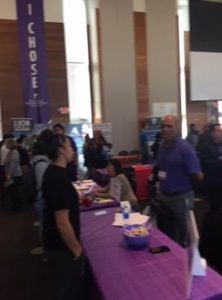
- As I hope everyone knows, the HLC Team will be here beginning today (Friday) and into early next week. As I also hope everyone knows, there were several areas of concern noted after our last visit. Here’s a few highlights. Much more information is available on our HLC website.
- We didn’t have a broadly endorsed and formally approved mission statement. Now we do and it has been endorsed by numerous bodies on the campus.
- We didn’t have a personnel handbook for visiting and adjunct faculty. Now we do…and we can prove it.
- We didn’t have any formalized policy for evaluating visiting and adjunct faculty. Now we do and faculty have been evaluated.
- We didn’t have many or enough formal processes for dealing with Center student concerns. Now we do, including a new Customer Relations position specifically devoted to Center student concerns. .
- We had no program to assess co-curricular programs and activities. Now we do and we have collected data.
- We had no formal plan for improving retention and completion. Now we do.
- We had a problematic CFI. Now our CFI is in the safe zone.
- We had no program of board professional development. That’s been taken care of.
- We could not demonstrate a budgeting process that addresses the Strategic Plan. Now we do.
Let’s be prepared to talk about these issues and the many incredible things that happen on our campus every day. If you’ve got a great HU story, tell it. Let’s not make our visitors guess about what we’re doing or ask them to fill in the blanks on their own. This is a time for HU Pride and so many great things are happening on our campus. We held the final HLC prep meeting yesterday with numerous faculty, staff, and administrators in attendance. It was truly an upbeat and forward thinking meeting and very gratifying from my perspective.
Greetings colleagues. A brief update for the week of October 23-27:
Last weekend was a busy one beginning Friday evening. An HU contingent attended the Council on International Relations (CIR) Gala in Santa Fe where we heard a nice talk from former Ambassador Nicolas Burns. Mr. Burns was the Ambassador to Greece and NATO and Undersecretary of State for Political Affairs at the State Department. Mr. Burns provided a broad perceptive on world affairs including a kind of alarming overview of contemporary threats and dangers as well as a great perspective as to how these issues have evolved over time. It was a stimulating evening. On Saturday, Joan and I kept up with the out-of-town football game via the RMAC streaming service and then attended the Zombie Tea in Kennedy where everyone sampled ghoulish snacks and heard Dr. Brandon Kempner give a brief talk on the history of zombie films and literature. I learned a bit of zombie trivia—George Romero, Director of the Night of the Living Dead, apparently lost a fortune due to the fact that the original theatrical distributor, the Walter Reade Organization, neglected to copyright the prints. Too bad for George Romero. Too bad for the Walter Reade Organization. But, a gift for all fans of the walking dead, the undead, the nearly dead, the soon to be consumed and dead, and the fully and completely dead. The zombie tea: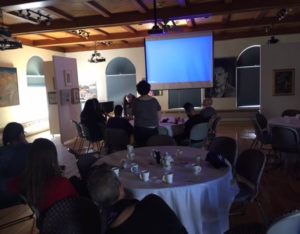
![]()
Zombie says….”I’d rather die—fully and completely expire—than attend another HLC preparation meeting. I’m ready. More than ready. Let’s do it.”
- The New Mexico Legislative Finance Committee heard the findings from a study recently completed by the state government titled Higher Education Cost Drivers and Cost Savings. It is an excellent report and I’ll soon provide the campus leadership with a copy and then have a discussion about next steps. Here’s a very brief summary of the report by Dan McKay, staff writer for the ABQ Journal:
NM colleges must improve efficiency
More than half of New Mexico’s colleges and universities are failing to meet a key benchmark for financial health, nonpartisan legislative analysts said in a report released Tuesday. And at least two institutions — Western New Mexico University and Northern New Mexico College — are spending nearly twice the national benchmark on administration and apparently “not enough on providing instruction for their students,” the report said. The 72-page report was shared with lawmakers Tuesday during a meeting of the Legislative Finance Committee. It’s “pretty alarming stuff,” said Rep. George Dodge Jr., D-Santa Rosa. The report outlined a series of incredible challenges facing New Mexico colleges and universities. They include:
- the danger of continuing to raise tuition. “With the highest poverty rate in the nation, even small tuition increases will threaten many New Mexicans’ ability to afford a college education,” the report said.
- falling enrollment. Demographic changes suggest the number of high-school graduates in New Mexico will start to fall within a decade. The state’s higher-education institutions, however, have a record of over-projecting enrollment and planning “for programs and space assuming significantly more students than actually enrolled.”
- the highest default rate on federal student loans in the nation. The federal government could impose sanctions on institutions if their default rate exceeds 30 percent. The Central New Mexico Community College’s default rate is about 28 percent.
- decreasing state money for colleges and universities. In fact, higher-education institutions in the state may already be receiving a disproportionate share of the budget, at least compared to other states. “New Mexico spends the highest proportion of taxpayer dollars on higher education in the nation, yet is the poorest state in the nation,” the analysts said in their report. Add it all up, and the state’s higher education institutions must improve their efficiency and better coordinate with each other to reduce duplication, legislative analysts said.
- On Monday, Brandon Kempner, Michelle Bencomo, and I visited the Albuquerque Center, Rio Rancho, and Santa Fe—all in one day. We spoke to students, faculty, and staff at each site. In total, we spoke to more than 100 people. Everyone seemed very well prepared for our upcoming HLC visit and I anticipate some strong participation from the staff, faculty, and students at Center locations. That was not the case last time. Speaking of Ms. Bencomo, her new position, Customer Relations Coordinator, is now advertised on the student portal and we are also producing some posters we’ll place in prominent locations in each Center. Here’s the poster—thanks to Sean Weaver for working on this:
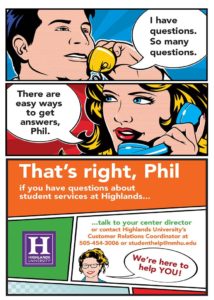
- On Tuesday, we held an open Student Forum in the SUB Ballroom. I provided an overview of campus happenings and responded to questions while our students munched on pizza. Dr. Brandon Kempner then went over the itinerary for the HLC visit and we both encouraged students to attend the relevant events to make certain a strong HU student voice was heard. It was a nice event with a good and positive vibe. I believe our students—all of them—students on campus, students at the Centers, and our online students—are about as prepared for the visit as possible.
- On Wednesday, we welcomed more than 150 high school students to our campus. These students from schools around the state are all members of MESA—the New Mexico Math, Engineering and Science Association. The students hope to major in a STEM discipline when they enroll at university. Along with other students from the region, the MESA students participated in our Annual College Night at Wilson Gymnasium, which we held in conjunction with Luna CC. Some photos from these events:
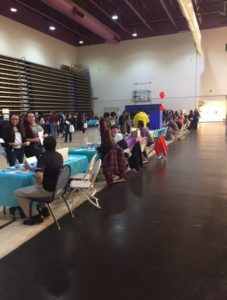
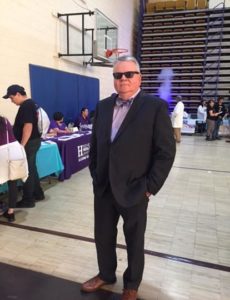
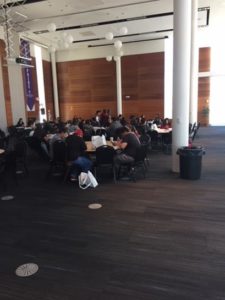
- We continue to make progress at Sanchez Field. The turf is down, the numbers and images are now placed into the turf, and the final installation steps are underway. The field as of today:

- I had another note from Dick Greene, our Jefferson Science Fellow working in Washington D. C. this year. Dick continues to advise about 70 USAID science, technology, engineering, and medical projects around the world and is also working on projects specifically focused on medical imaging. He is apparently having a great time with the exception of the days he has to wear a suit, which he does unwillingly while grimacing.
- The Association of Governing Boards (AGB) is the premiere national organization providing guidance to boards, presidents and chancellors, faculty members, and staff members regarding best practices in university governance. The AGB recently published a brief update on shared governance (go to:https://www.agb.org/sites/default/files/u27335/2017_statement_sharedgovernance.pdf). I am urging our board and campus leadership to come together to discuss the ideas in the new AGB publication. I also urge other members of the community to familiarize themselves with the publication. It would be a wonderful thing if HU became a model in the state, region, and nation for modern shared governance.
- One week to go…
Greetings colleagues. A brief update for the week of October 9-14:
- One of the Strategic Goals for 2020 is technological advancement and innovation. Most people agree that institutions of higher education lag behind most businesses in technological innovation. We tend to do business the same ways we handled things years ago and as a result, our business processes tend to be, at least in some cases, pretty flabby and unfriendly. Issues related to paying bills, getting registered for classes, and just getting things done are very common concerns in colleges and universities. Frankly, I’ve never worked at any institution where these kinds of things were not considered problems. I hear that at HU too, but really no more so than other places. Nonetheless, it is important that we do what we can to make these processes as efficient as possible. That saves time for other things, makes for a more positive experience for our students and others who do business with us, and also improves the work environment. When it takes too long to get some simple thing done, people can get frustrated and sometimes worse. We recently launched Touch Net to allow people to make secure payments to HU. Now, students and others can simply and safely pay their bills and do their business online. This was a major accomplishment here and I thank Joe Geri, Max Baca, Paula Escudero, and everyone who made it happen. Well done.
- Another of our Strategic Goals 2020 is to engineer high-impact programs and learning experiences. We’ve made some good progress on this in recent years. Our ongoing commitment to Learning Communities, our successful HIPs campaign last year ($3/4 million added to our corpus), and numerous other initiatives are a few examples. Yet another example is the Joseph Montoya Internship Program. This new opportunity, supported by a generous benefactor and alum of HU (Mr. Joe Montoya), provides support for one of our students to spend a week or so in Washington, D.C.to more fully understand the inner workings of federal government. Of course, it is possible that the student will also make some connections there that may lead to an internship or even a job. You never know. Here’s some additional information about this opportunity:
This internship program is a high impact practice designed to expand students horizons, gain invaluable experience and serve as Highlands representatives, bringing visibility for NMHU in an area distant from campus, but critical to the University. The long-range goals are to build a peer and alumni network of influence in the heart of our federal government. The funds are available through a Joseph Montoya Internship. The successful candidate will receive a lump sum stipend of $5000 to be used for airfare, living expenses, and purchase of necessary items for their internship (appropriate clothing, technology, etc.). The candidate will work with a faculty member who will design an appropriate assignment or reflective paper to be submitted upon return from the internship. In addition, the student will do a presentation on campus open to students and faculty to share his/her experience and knowledge gained from the internship. Applicants will complete the application form and submit the form together with their resume and two letters of recommendation. As part of the application, the faculty member must be named, an internship identified with a specific organization, and a description of the assignment/paper that will be provided
More details about this program can be found here: http://cte.nmhu.edu/studentinternship/. Many thanks to Mr. Montoya and to our Advancement Office for bringing this opportunity to our campus. Please encourage some students to consider this program.
- Yet another High Impact Practice at HU—-several HU undergraduate and graduate students recently attended the New Mexico Geological Society Fall Field Conference in Quary, CO. Our students interacted with more than 125 professional geologists and were immersed in presentations about the geologic, glacial, and mining history of the region. Many thanks to Dr. Jennifer Lindline and others for assisting with this great trip. A few photos of the excursion—wow, check out the scenery on that last photo. Is that a postcard or what? Beautiful.
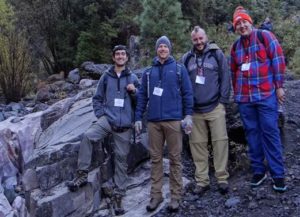
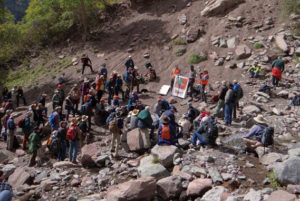
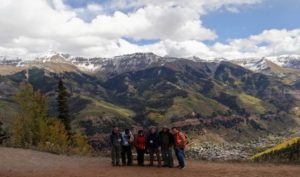
- It is pretty easy to explain the pinch so many agencies, including higher education, have felt and continue to feel here in New Mexico. Go to: https://www.abqjournal.com/1075078/nms-budget-from-flush-to-cash-crunch-in-9-years-excerpt-oil-boom-housing-bubble-led-to-good-times-that-didnt-last.html. This graph explains it well:
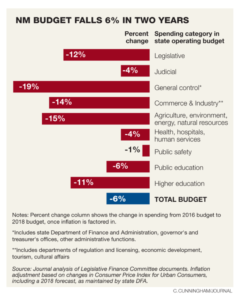
- A nice video loop of the efforts made by our students in Texas: https://vimeo.com/237462087?utm_source=email&utm_medium=vimeo-cliptranscode-201504&utm_campaign=28749. I have heard so many favorable comments about the work of our students there. It was a true demonstration of Cowgirl and Cowboy Pride and selfless dedication to others.
- We held our weekly leadership team meeting on Tuesday. We started the meeting with an update regarding the DACA program. We read this brief article: http://www.cnn.com/2017/09/04/politics/daca-dreamers-immigration-program/index.html. Professor Eric Romero kindly joined us to discuss the specific situation on our own campus. The wheels are very much in motion when it comes to the DACA program and I really do not think any person knows what will happen. It is gratifying to me that there continues to be widespread support for DACA on our campus, statewide (the Council of University Presidents have gone on record in support of the program), and our senators and representatives in D.C. have also expressed support for DACA. We also discussed recent HLC issues, personnel matters, and other issues.
- On Wednesday, I made a presentation to the local Kiwanis Club. Clearly, we have many good friends in the community who support HU and are actively looking for ways to do more. One suggestion I heard was to tap more into local assets (e.g., retired teachers, retired business people,, etc.) to provide additional tutoring support to our students. I will look into this excellent idea. Also on Wednesday, the Board of Regents met to consider an article regarding the possible granting of tenure to administrators. They voted to approve the article.
- On Thursday, we held a meeting focusing on our various retention efforts. I regret that I was unable to attend that one since I needed to attend a meeting regarding our recent audit. There are a few more things we need to attend to, but the audit is going well and I thank those who devoted so much time and energy to it. Later that evening, I welcomed attendees to the new exhibit and lecture series, Native Voices: Native People’s Concepts of Health and Illness. The interactive exhibit is in the Ray Drew Gallery and I encourage everyone to stop by. It is really excellent. The artist and author, Roxanne Swenzell, gave a nice talk titled The Pueblo Food Experience. A review of her book published by the New Mexico Press appears below. Thanks to all who brought this worthwhile exhibit and lecture to our campus.
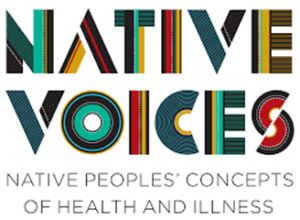
REVIEW OF THE PUEBLO FOOD EXPERIENCE COOKBOOK: The Pueblo Food Experience Cookbook is an original cookbook by, for, and about the Pueblo peoples of New Mexico. This cookbook is a product of the Flowering Tree Permaculture Institute, founded by Roxanne Swentzell at Santa Clara Pueblo. Its goal is to promote healing and balance by returning to the original foodways of the Pueblo peoples. The precontact, indigenous diet emphasizes chemical-free meat, fowl, fish and a wide variety of whole grains, nuts, seeds, fruits, and vegetables. Buffalo Tamales, Blue Corn Cakes, and Rabbit Stew are just a few of the unique and delicious Pueblo recipes. Five thought-provoking essays contribute to the understanding of Pueblo history and culture. Though written in the Tewa Pueblo of Santa Clara, indigenous peoples everywhere and anyone interested in learning about Pueblo culture and food will delight in this book.
A photo from last night’s well attended lecture: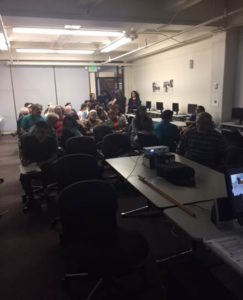
- Our Advancement Office continues to do good work. This week we secured a $10,000 gift from a generous donor. Our new software program, Raiser’s Edge, is almost fully implemented now and that should improve our performance even more.
- I heard from several individuals about the concept of an HU Futures Group. Again, this will not be a policy making body or a group that formally approves any idea coming forward. We have other processes in place for all that and I have no interest in changing that. The group will simply meet over breakfast to talk about some new things we might consider in the immediate future. What interesting projects and or programs do people have to differentiate ourselves from other institutions, draw more students to us, and strengthen HU in some meaningful way? The first breakfast meeting will be one week after our HLC visitors leave campus. We’ll meet November 14 at 8:30 in the President’s Conference Room. This first meeting will be small—ten people. If you are interested in attending, let me know. Thanks so much.
- Several HU colleagues have contacted me recently to express their concerns about sexist, racist, and other inappropriate comments they have heard or have been directed toward them individually. It is unclear if these comments—sometimes yelled out of windows as cars drive through the campus—are made by students or nonstudents or others. That does make a difference, of course, as we have promulgated a number of policies relating to this kind of behavior in regard to our students and employees. However, students or employees or not, this kind of thing is not acceptable at HU. Coming to work every day and trying hard is tough enough. People should not be hassled or embarrassed or insulted while they are here—or anywhere else for that matter. I am working with others to address this. I’ll soon be speaking to Dr. Kim Blea, the Diversity Task Force, and other individuals and groups. In the end, it is ultimately up to each one of us to model on a daily basis the kind of environment we all want to work and live in even when others elect to behave otherwise.
- The dirt work at Sanchez Field will be completed today and we have contacted Spin Turf (the company providing our new turf) that we’ll be ready for them next week. This project will come to a successful conclusion soon. Thanks to all who made this happen.

- I have had a little back and forth from our good (former) colleague Kerry Loewen who now works at Santa Rosa Community College, which is located at the very center of the wildfires in California. Kerry is safe, but he sent me an interactive map of the fires and the devastation there is incredible. I know that everyone wishes him, his family and loved ones, his students, and his new colleagues all the best during this tough time.
- Several notable activities will take place this Friday evening. An HU contingent will attend the annual MANA de Norte Gala in Santa Fe. This is an important event where worthy students from throughout Northern New Mexico receive scholarships. That same evening, we’ll welcome Cheech Marin and Tommy Chong to our campus for an 8:00 p.m. concert in Wilson. The duo has performed comedy acts for many years and also appeared in numerous films and TV. Brief bios for these two from their website (http://www.cheechandchong.com/):
One half of the comedic duo Cheech and Chong, Richard “Cheech” Marin has become perhaps one of the most well-known and respected Chicano achievers in the world of entertainment. As an actor, director, writer, musician, art collector and humanitarian, Cheech is a man who has proven that he has the intellect and wit to make a simple smile appear in any situation. At the side of his partner Tommy Chong, he enjoyed immense comedic success in the 1970’s before moving into a diverse range of roles, having appeared in more than 20 films, including Spy Kids, Tin Cup, and Once Upon A Time In Mexico. His television credits include co-starring with Don Johnson in the popular CBS drama, Nash Bridges, a recurring role on the hit series Lost, and a guest appearance on Grey’s Anatomy. Other films include The Perfect Game (Lions Gate Entertainment); Beverly Hills Chihuahua and Race to Witch Mountain (Walt Disney Pictures); and The Miracle of Dommatina (Hallmark Channel). Marin has also become a well-known collector of Chicano art, and owns one of the most important private collections in the United States. His collection formed the core of the traveling exhibition titled Chicano Visions: American Painters on the Verge, which has shattered attendance records across the country.
Grammy Award winning comedian Tommy Chong is legendary for his invaluable contribution to American culture as part of the iconic comedy duo Cheech & Chong. During their reign, the twosome recorded six gold comedy albums, including the 1973 Grammy winner “Los Cochinos,” and starred in eight films, most of which Chong co-wrote and directed. The first film was the highest grossing comedy of 1978, topping $100 million at the box office. Others were Cheech and Chong’s Next Movie (1980), Nice Dreams (1981), Things Are Tough All Over (1982), and The Corsican Brothers (1984). Born in Edmonton, Alberta, Canada, Tommy began his entertainment career as a musician in a Canadian-based rhythm and blues band. Eventually, he landed a gig with the “Vancouvers”” and co-wrote the band’s 1960’s hit, “Does Your Mama Know About Me.”” From here, Chong eventually turned toward life as an actor. The first step was forming “City Works,” an improvisational group where he consequently met his future comedic partner, Richard “Cheech” Marin.
- HLC Update: The schedule for the HLC visit team is just about set. Brandon has visited many departments to provide another update on our numerous efforts to address each and every HLC issue. He has a few more to go, but that is going well. He and I and few others are set to visit the Centers and provide yet another update. Caro has made all the necessary arrangements for the team to feel welcomed at the Plaza. We’ve received requests from the HLC team for a few additional documents, but only a few so that is a good sign. A few weeks to go and frankly, I cannot imagine that we could be any more prepared.
Greeting colleagues. A brief update for the week October 2-October 6:
- In the last Assurance Argument, the HLC suggested that we needed to be more organized in regard to communicating with Center students information about the various support and other services available at each location. We have organized all of this information into tri-folds and have now made them available to each Center. Now, students can simply refer to the appropriate tri-fold and then contact the relevant office/person to get things done, get questions answered, etc. If those efforts do not result in a response that works for the student, we have another avenue that has been engineered to get the job done. A Center Specialist will be available to answer the phone or respond to emails from Center students and that Specialist will stick with the student until the issue is fully and completely resolved. In essence, the Specialist will function as a kind of ombudsman to help students with whatever problem they are experiencing. This is a very high level of service, in my view, and is a strong testament to our commitment to serve all of our students well. Here’s a copy of the trifold for students at the Santa Fe Center:
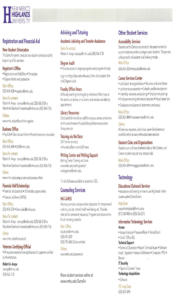
- For several years, the College Affordability and Transparency Center has published the College Scorecard, which is designed to assist students, parents, and others to examine college costs. Here’s the most recent statistics from College Scorecard. As you can see, HU is the most affordable institution among those listed below and after graduation, our graduates do well on the salary measure. Some of the differences are striking. For example, we’re $4,665 less than Western and yet our graduates earn $5,000 more. That’s good, but….look at our graduation rate. We lag behind our in-state peers and Adams in Colorado. This is the area we must press on. It is not acceptable and I am sure you agree. We are working diligently to improve this number—our learning communities, participation in the HLC institute where we are working on advising, more attention to responding to students who need assistance in offices throughout campus, more tutoring services, and other measures—but no single intervention or collection of interventions will show immediate improvement. But, we must continue to try. It is also important to not discard some effort if there are not immediate improvements. The only immediate improvements are made when an institution becomes more selective. That, of course, is antithetical to our mission and I am not in support of that at all. We have always done a good job with students who come to university fully ready to learn at the collegiate level, well resourced, committed to completion. Of course, many of those students are from wealth and will probably do well no matter what. Students in other demographics? We’ve (in the higher ed sector generally) have not done all that well. That space is where the real action is in American higher ed. So—some good news from the College Scorecard and some we must continue to address in order to make improvements. Programs to improve retention and graduation rates sometimes work…sometimes not—but you really can’t beat the most basic of all interventions—when an HU faculty member, staff member, or administrator goes the extra mile to express sincere interest in and concern for a student, how that student might be assisted in some way, and or what might be done to help that student overcome some hurdle. I see examples of this kind of thing all the time. Now somehow institutionalizing that and making it an even bigger part of the culture—that is hard to do, but not impossible. My take—let’s bravely face the challenges noted in the Scorecard, but also celebrate our good outcomes. Those are substantial.
institution average annual cost graduation rate salary after attending
HU $6.971 18% 35,600
Eastern $9,938 31% 29,300
Western 11,636 21% 30,600
UNM 9,027 48% 34,900
NMSU 9,663 44% 33,400
Adams St. 16,212 24% 34,200
- HU is leading the state in reducing the number of hours required for a baccalaureate degree. Without some careful monitoring, baccalaureate degrees (intended to be four year degrees) can grow and grow and grow until it is virtually impossible to finish in four years. The math here is simple. Complete 15 hours of classes each term for eight terms and you get to 120. Add even one more class and a student has to complete more than 15 hours at least one term and or attend summer school and or attend an extra semester. That’s a problem, especially for students borrowing money to attend university. No one I know is interested in adding to the time students must be on campus and thereby adding to their debt, but faculty are always interested in providing students with the best possible education and in some cases, that results in programs expanding beyond 120. In my view, we’ve done a good job keeping programs at 120 while maintaining the quality of a degree. We were highlighted at a recent meeting of government and university officials. To read the story, go to: https://www.abqjournal.com/1071000/gov-nm-universities-streamlining-degree-hours.html
- I am very pleased to announce that HU will partner with LANL and a local school district to improve the performance of students in the STEM area and make meaningful improvements in teacher preparation and school operations. The Partner School Initiative (PSI) kicks off this year with several planning meetings. In my view, this initiative has the potential to once again put HU’s teacher education out in front of others and once again attain a preeminent position in the state and even region. Here’s a quote about this initiative from the LANL Community Connection website, “The aim of the Partner School Initiative is to develop a model for elementary education where pre-service teachers, in-service teachers, and principals have opportunities to continually improve their practices,” says MSA Education Specialist Lorenzo Gonzales. New Mexico Highlands University has been selected as the higher education partner in the program, which marks an expansion of the professional development work MSA has done for area teachers for 16 years. “Bringing together all our experience into one school will allow us to have more impact,” Gonzales says. Pre-service teachers studying at Highlands will complete their required classroom experience at PVSD, while the educators currently teaching there will work with the MSA to learn best-practice approaches to math and science education. “I am pleased that the Pojoaque Valley School District was selected as the Partnership School,” says Melville Morgan, Superintendent of Pojoaque Valley Schools. “The innovative opportunity to partner with Los Alamos National Laboratory and New Mexico Highlands University will help us to further develop the capacity of our teachers and leaders, for the benefit of our students. This is an exciting time for our community.”
- Our intrepid Texas Hurricane Volunteers returned to us Sunday evening after devoting their time and efforts to the victims of the natural disaster there. Our team worked in distribution centers, prepared homes and other structures for ultimate renovation, and assisted in many other ways. Thanks to the HU team and everyone who made this happen. A few photos of the work there:
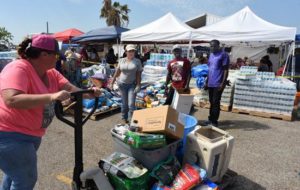
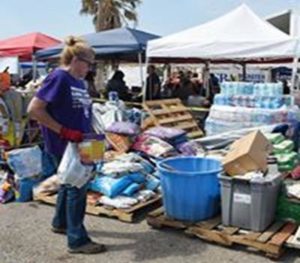
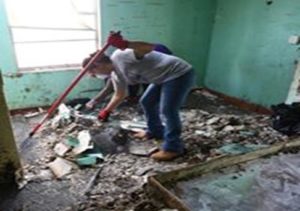
- Congratulations to Dr. Robert Karaba, Associate Professor for Educational Leadership, who recently published his book, Making Sense of Freedom in Education: Three Elements of Neoliberal and Pragmatic Philosophical Frameworks. His book interprets our current cultural educational practices of marginalizing civic education and the humanities. Also check out the new children’s book by Rod Sanchez. The book, Ben and IQ Explore Hot Air Ballooning is a collaboration involving the Center for Hands On Learning in Rio Rancho and the Albuquerque International Balloon Fiesta. Well done to both of these good colleagues.
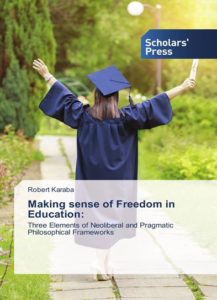
- On Wednesday I held the monthly open forum for all interested faculty and staff. About 50 people attended. I briefed the campus community on a variety of activities in numerous domains including facilities, academic affairs, the HU Foundation, Student Affairs, athletics, and others. Thanks to all who attended. Speaking of facilities, we continue to make good progress on the turf replacement and barring any major additional rains, we should be done by the end of the month. We always welcome any form of moisture in Northern New Mexico, but let’s hope for a brief hiatus when it comes to rain. On Thursday, I and several of my colleagues toured the Comm Building in preparation for the upcoming move out of Rodgers. The sequencing of the move has been very orderly and professional in every respect and I thank Ms. Baca for her hard work to get this done with minimal disruption.
- On Thursday evening, Joan and I will welcome this year’s recipients of the Viles Foundation scholarships to a reception at the University Residence. Several Viles board members will also attend the reception. The Viles Foundation, named after Ms. Matie Viles, supports deserving students from San Miguel and Mora Counties. Over the last 58 years, the Viles Foundation has provided $2,473,153 of support to 887 students. That’s really a wonderful record. Many Viles students have attended HU and many graduated from HU and went on to lead successful, prosperous, and meaningful lives. Of course, one of our residential facilities is named Viles-Crimmins in honor of Matie Viles. An early photo of Ms. Viles:
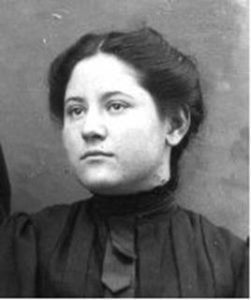
- As golf season winds down a bit, I am pleased to report that I’ve received a number of very nice unsolicited notes about the course and our management of Gene Torres. Three individuals as well as the Las Vegas Women’s Golf Association have contacted me recently to comment on the course. One letter I received asserted that Gene Torres was, “the best of all courses we played” this year. Congratulations to Justin and the entire grounds crew for doing such a great job. Well done. Our course is a wonderful university, community, and regional asset. It is challenging to find a way to meet the fiscal requirements out there, but I am pleased we continue to be able to do so.
- On Friday, I’ll drive to Santa Fe to participate in an NMHED meeting focusing on common course numbering and other approaches to promote easy transfer. This initiative has been going on for some time and is now coming to a conclusion. Many thanks to Secretary Barbara Damron for her leadership on this.
- Work continues in preparation for our HLC visit. The schedule is about set. More than 40 invitations have been sent to community members to visit with the team over breakfast. Dr. Kempner has met with numerous departments to prepare them for the visit and he’ll meet with the remaining units soon. We held a Facebook Live event on Wednesday afternoon where interested people could hear about everything we’ve done in regard to the HLC Criteria (more than 190 views), and I reviewed our HLC efforts at the October Open Forum. All of these activities took place over the last several days so you can see we are truly all hands on deck to prepare for the visit. In my view, the tone on campus in regard to the upcoming visit is very positive. Everyone is well prepared to share who we are, what we do, and to discuss in some detail what we’ve done to address the HLC criteria. In a very real way, our upcoming accreditation visit has brought the campus together in a pretty powerful way. There is more work to do, of course. The actual visit is in about a month. Then, we must go to Chicago for the IAC meeting and then await the board’s ultimate and final decision. We can and never will (as long as I am here) just “check off” on accreditation issues and move to other things. That’s how an institution gets into trouble. But, I ask you to dream a bit. The HLC visit is over. The IAC visit is over. The HLC board has met and…all is well. The time of intense inward examination is over (although, as I wrote, accreditation can never be put on “hold”), so now, what is our future? Let’s look outward and in a forward manner. What is the path to excellence at HU? What programs and services do we hope to add to distinguish ourselves from other institutions? How can we modernize and streamline things to do the business of our work in a more efficient way, thus leaving more time for our real work—teaching our students, making new knowledge, and serving humankind? How can we more powerfully tell the HU story and attract more students to our institution? What can we do to keep more of them here and graduate more of them on time and with low debt? True, we face many challenges even with accreditation temporarily off the table, but what can we do—ourselves—to move toward excellence?
Of course, mere thinking and talk about all this is not enough. I’ve sat around many round tables in my career where that kind of thinking and talking was in high evidence and then…nothing really happened. I imagine we’ve all had that experience. So…what to do. In the past, I’ve employed a pretty simple process where people get together not to “problem solve” (that is often necessary, but focuses on things already challenging in the organization), but rather to focus on the future…a positive future crafted to result in exciting, meaningful, and excellent outcomes. To wit, I’d like to try an approach I call HU Futures. This would be a brief series (probably 4-6 meetings) where I’d invite people for a light meal (probably breakfast) where we’d talk to each other about the future of the institution and the hopes and dreams we have for it. This would probably start this November or possibly December. We wouldn’t do problem solving at all although I understand that many issues, concerns, and challenges must be addressed here as is true in any organization. But rather, what is the best possible future we can imagine for this place? Ideally, I’d like for the groups to be small and formed in a horizontal team fashion—that is, people from different areas with different jobs and of course, different perspectives. That’s the idea. What might fall out of this type of discussion involving long term HU faculty, newer faculty, administrative assistants, custodians, students, administrators, and others? Let’s think about throwing external folks and maybe board members into the mix. This would not be any type of policy making body or group…we already have those structures in place. But, it might be possible that one or more ideas come out of all this that are good enough to catch hold and then be vetted by our regular approval processes. Then, we’d implement at least on a trial basis. This would also not be a strategic planning group or an attempt to do overall strategic planning. We have a Strategic Plan that is good until 2020. And I am not in favor of modifying it at all until we closer to that date. The idea here is to get some new and exciting initiatives in play well before that date. In truth, it was my plan to do this during my second year here. The plan was to use Year #1 to get some personnel and structural pieces in place and then to pursue the path to excellence visioning activity in Year #2. That didn’t work—due to the time, effort, energy, and money we’ve had to devote to getting back on track with our accreditor. So now, time to move forward. I’ve done this kind of thing before and had some success with it, but of course, it has not always been fully successful. It is not really realistic to think that it will also work well. Indeed, most ideas that flow out of this kind of thing do not catch fire and move forward. But, some do. My colleagues, I welcome your thoughts about HU Futures.
Greetings colleagues. A brief update for the week of September 18-22.
- Last weekend was a whirlwind of activity beginning with participation in West’s Homecoming parade, the President’s Homecoming Coffee, our own Homecoming parade, a beautiful cocktail reception, silent auction and alumni reception in the SUB, the Mike Super performance, a wonderful recognition of Leveo and Patricia Sanchez (celebrating their generosity and the successful ending to the Home Field Advantage Campaign), the Homecoming football game, the Alumni Awards BBQ, and finally, a dinner at the University Residence celebrating the opening of the New Mexico Painter’s Show (which is still up and fabulous…you should go). This year’s Homecoming was, according to so many I have spoken with over the last several days, one of the best ever. There were so many great events—well organized, well attended, and a good and positive vibe about HU and our mission. There is always a risk when one singles out people to thank for what are clearly team efforts, but I must thank Terri Law and her team, particularly Juli Salman, for her excellent work, Margaret Gonzales for organizing a great Homecoming parade (again, the “best” according g to many people), and so many others for their high dedication to this task. The planning is already underway for next year’s event…if you have any thoughts, please let Juli Salmon know. One change I will make is that there will be a President’s Reception Area and Tent at next year’s tailgating event. Joan getting set for the West Homecoming parade and the two of us about to help dentists across Northern New Mexico to make some boat payments by tossing incredible quantities of candy to happy children. Also, various shots from other homecoming events:
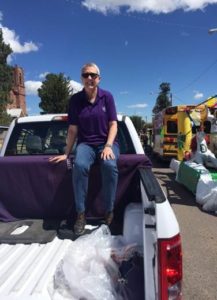
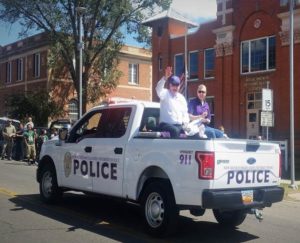
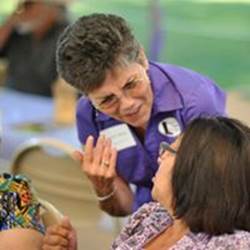
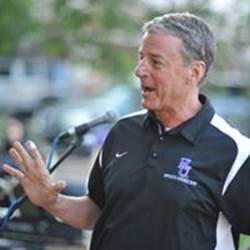
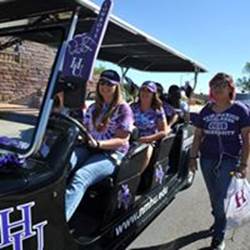
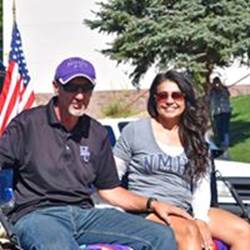
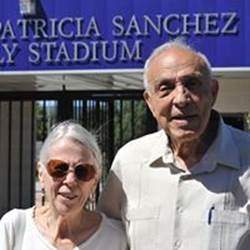
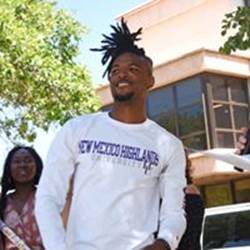
- Many thanks to all who helped organize and lead the STEM Showdown at the Rio Mora Refuge this week. The “showdown”, a partnership between HU and the Denver Zoo, brought 20 Highlands faculty together with students from seven high schools to learn about science and the many benefits of a great HU education. High schools from Las Vegas, Albuquerque, Espanola, Santa Rosa, and Bernalillo participated in this event. Our own Joe Zebrowski is the university’s liaison with the Refuge and played a major role in organizing this event. Dr. Corey-Rivas talking with a student at the Showdown:
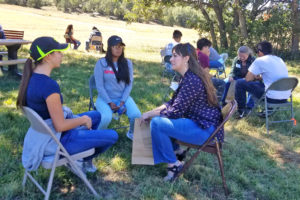
Photo Courtesy Denver Zoo
- On Tuesday of this week, Dr. Brandon Kempner and I visited the Farmington Center and spoke with various students as well as the faculty and staff there about the upcoming HLC visit, what they might expect during the visit, and answered questions. I also visited with the President of San Juan College who has been such a great partner to us. In my view, our colleagues in Farmington are on the front line of HU’s mission. They serve so many students who face some pretty daunting challenges and yet persevere to attain their degrees and go on to good jobs and lives of deep meaning and purpose. I salute our Farmington students and thank our wonderful staff and faculty there for their high and noble efforts.
- I drove back from Farmington Tuesday evening and attended the Foundation Board Retreat on Wednesday. The board and staff members from Advancement heard an excellent presentation on best practices related to Foundation Board membership. We also did some strategic planning (where does the Board want to be next year, in five years, etc.?), and ended the day with a discussion focusing on board development and succession planning. We now have a very professional Foundation Board with clear goals and solid metrics for measuring how well we’re doing and…we are doing quite well. I am very pleased with the performance of the Foundation and look forward to continued good work in the advancement domain.
- On Thursday, we dedicated a plaque in Ilfeld to provide visitors with information about the murals hanging in the lobby. These murals were originally created by Brooks Willis, a WPA artist from Santa Fe. As you may know, one of the murals was damaged some years ago and later, the other murals were actually painted over. The story I heard was that the president at the time wanted the foyer of Ilfeld to look more modern. Yikes. The painted over murals were eventually restored and in 2015, the WPA Association sponsored a competition to select an artist to create the mural previously destroyed. A Highlands student, Ms. Dyna Amaya-Lainez, won the contest and created the new mural. I encourage everyone to drop by Ilfeld to see all of the murals and the new plaque. A photo of the dedication of the plaque and the cover of a wonderful book focusing on New Deal art in New Mexico. This is really a fascinating book and I encourage interested people to take a look.
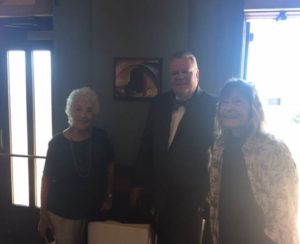
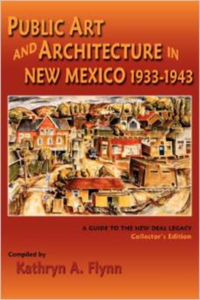
- Ideally, where should faculty live? This is kind of a third rail question and often evokes some controversy. I think most academics would say that ideally, faculty and administrators should live close to campus thus promoting the kind of “learning community” described by an early president of Harvard University who said, “The faculty must reside in close proximity to students and live on a daily basis the shared commitment to the University and the life of the mind. This arrangement promotes the kind of place of learning all great institutions desire.” In the mid-1800s, President Francis Wayland (president of Brown University) actually ended the university’s medical program when the physicians on faculty refused to live on campus. Eventually, they moved very close to campus, which was apparently good enough for former President Wayland. He allowed the medical program to proceed. Personally, I think it is beneficial and desirable to live close to campus. You run into students in informal and social settings. You may be more accessible to students (though technology has partially addressed that matter). You are probably more likely to get engaged in the civic life of the town/city where the school is located. There are other potential benefits. In several situations, I’ve lived very close to the campus I’ve worked and for me, these potential benefits have all been true. But, we are all more than faculty and administrators. We are more than employees. We have complete lives with many needs and desires and in some cases those mitigate against an interest in living close to the campus. For example, once my wife and I had a pressing need to live close to a certain type of medical care needed by one of our kids. That came first. If it boiled down to taking a job—even a very desirable job—where I was required to live near the campus (sans the medical care we needed) or not taking the job—well, I would not have taken the job. Fortunately, I did not have to make that decision. In some cases, people have kids with various special educational needs and once again, if it was a choice between meeting the needs of one of my kids and the requirements of some job….kids win and every time. I think most people would say that. The bottom line for me is that we should encourage university folk to reside close to campus, but I draw the line on actually requiring it in all cases. In truth, today many faculty teach as much online as face-to-face so that makes any requirement to live in town a little more complex, but still, I feel that living where you work is a good thing. I feel a little more strongly about executives. In most cases, I think they should live in or near town unless their job activities take place out of town on a routine basis. As it happens, all HU executives do live in or near town with the exception of our VP for Advancement and in that case, her work activities take place as much in Santa Fe and Albuquerque as here in Las Vegas. Otherwise, everyone lives here or close by. When it comes to the faculty, my preference is to encourage and possibly provide incentives to make that happen. Here’s a recent article describing some efforts on other campuses to promote this activity (go to: https://www.yahoo.com/news/more-innovation-colleges-push-faculty-live-near-campus-153252715.html) and the issue is really about employees other than university faculty members (see this article: http://www.pewtrusts.org/en/research-and-analysis/blogs/stateline/2013/03/18/should-public-workers-have-to-live-where-they-work). There are some potentially relevant ideas in each of these articles and I think we should consider them. Is some type of requirement to live close to campus really just another form of government or employer interference in private matters? On the other hand, many schools require some or all students to live on campus to help form a strong intellectual community…why should we not do the same for employees of those campuses? In regard to our own situation, what if we built some nice apartments, condos, or homes on our golf course and used them as a partial incentive to get top recruits to work here? I don’t know about you, but when I first got out of school I needed income, but I was also concerned about how far that income would go and the cost of housing was a big piece of that. Throw in some housing incentive and that would have been very attractive, at least for me. Alternatively, we could possibly provide some direct resources (money) to new employees to encourage them to settle in or near town. These and similar arrangements are not at all unusual in the higher ed sector. A president of an institution in California recently told me that he would not be able to recruit top talent at all unless the campus provided some incentives to those top applicants. The cost of housing there is sky high and although salaries there are also higher than here (or most other places, for that matter), the increased compensation does not even come close to the increased cost of housing. I am seriously thinking about all this and I welcome your ideas/thoughts/suggestions as I form my own.
- The Mike Super concert was a great success with our students and the concert was nearly sold out altogether. We sold numerous tickets to members of the community and we’ll plow those dollars back into the Arts@HU series. Tickets to the Cheech and Chong concert go on sale soon and of course, tickets will be free to our students. Bike rentals at the Outdoor Recreation Center continue to be very popular and we may purchase some additional cruiser type bikes for excursions around town. We are also planning to add even more ski trips this year and possibly purchase some ski clothing we’d make available to our students. Many students who participated in one or more ski trips last year had never skied before and they did not have the proper clothing. We can fix that and we already have washers and dryers to clean the snow suits after use.
- I heard from Dick Greene this week—HU Professor and Jefferson Science Fellow working in Washington D.C. this year. Dick reported that he continues to work on several large scale international projects. He advises elected officials on the scientific worthiness and merits of these projects. In addition, Dick is advocating for more STEM research dollars, but reports that the immediate outlook is rather grim. There will apparently be fewer dollars allocated to scientific research—not a good outlook at all. He does report having a great experience with his colleagues in DC –mostly newly minted, but top-notch Ph.D.’s from the best programs in the country. He apparently gives them plenty of free advice from an elder statesman perspective since…well…he is older than virtually all of them. He has the elder issue well in hand. The statesman piece….not so sure about that. He also reports that he must wear a suit at least once per week—a daunting challenge for him. In short, he is doing great things, having a great time, and representing HU well, no doubt.
- Some interesting data regarding the composition of various faculties in New Mexico—HU employs more tenure track faculty than NM Tech or Western and only a few less than Eastern (which has a much larger enrollment). Approximately 35.3% of our faculty are from a minority group compared to 10.7% at Eastern, 27.3% at Tech, 28.8% at State, 26.6% at UNM, and 21.8% at Western.
Data from Diversity in Academe, September 22, 2017, page B40.
- The arrangements for the HU Hurricane Relief Project are about set. Our team is leaving Wednesday, September 27th at approximately 5:00 p.m. They’ll be traveling to Dr. Ben Nelson’s residence six miles outside of Rockport (thanks Ben!) where everyone will camp. At this point, there are approximately 38 people signed up. The group will return Sunday, October 1st. The HU volunteers will be working at agencies such as a local Senior Center, the City of Rockport and a local Donation Center. Transportation is being provided by Herrera Coaches. Sodexo is providing snacks for the trip and several other local businesses have or will be donating to the effort. Many thanks to all who have volunteered for this experience and to Dr. Beth Massaro and her team for organizing the excursion. We are sending a photographer/videographer on the trip to capture the good work HU volunteers will do there.
- In an attempt to improve our service to students, particularly those who reside on or near campus, Dr. Kim Blea has worked with her team to begin some new programming. We will soon begin a “Walk In Wednesday” program where Ms. Yvette Wilkes and Mr. Roman Baca visit the residential facilities to hear what’s on the minds of our students, a “Table Talk” program designed to also provide more input to us about housing issues, and a series of life skill programs focusing on, for example, personal money management. No organization is perfect, of course. But, the best organizations make sincere efforts to improve. These are but a few examples of our efforts to improve our outcomes. Thanks to all who are doing this work.

- This Week in HLC Accreditation (from Dr. Kempner): Now that our Assurance argument is complete and turned in to the HLC, we have been communicating with the HLC peer reviewers to coordinate their site visit November 6 – 8th. They will hold forums with faculty, staff, students, and the community, as well as lead numerous meetings about the criteria and Assurance Argument. Please mark those dates on your calendar. We have another HLC update forum on Monday, September 25th, and I’ll share some of the draft details of the visit with you then. This week, President Minner and I visited the Farmington Center on Tuesday (9/19) to discuss accreditation with center faculty, staff, administration, and students. Thanks again to Buddy Rivera for hosting us, and we spoke with over 50 students in a number of different classes about accreditation and campus issues.
Visioning Exercise: All HLC issues are successfully resolved. What is the path to excellence at HU?

Greetings colleagues. A brief update for the week of September 11-15.
One of our Strategic Goals (2020) is to be the best possible community partner to the City of Las Vegas and the broader community. We take this goal seriously and work closely with local officials, businesses, and others to improve Las Vegas. A few recent examples—while the local city recreation center was being renovated, we made recreational and workout spaces available to community members right here on our campus. No charge. Beginning this fall, on MWF we offer $5.00 all-you-can-eat lunches (including takeaway lunches) in our cafeteria. There is no better lunch deal in Las Vegas than five bucks for all you care to eat. The performers we bring to campus for our students are also available to local community members. Tickets to these events are almost always much less than people would pay in other locations. For example, tickets to see the comedians we are bringing to campus in October are about $54 less than someone would pay to see them in another venue. We recently welcomed a local non-profit, the EDC, to our campus in exchange for services they would provide to us. We had a great Portraits of The West exhibit on campus and all were welcome to that—no fee. Our New Mexico Painter’s show opens soon and again, everyone is welcome to attend that at no cost. Last summer, we offered several free workshops to local youth in the STEM area. No cost whatsoever. These are but a few recent examples…there are many more. Of course, we continue to provide a variety of programs and services to the community including Movies at the Ilfeld (free late run movies…absolutely no charge to anyone who wishes to walk in…a rather incredible community program), low cost access to classes and programs for community members, access to our pool, and many other programs and services. Of course, everyone recognizes that providing these programs and services at low cost or for free actually costs the university something—for example, our employees have to be at the Ilfeld for “free” movie night—but we are firm in our commitment to continuing the community service tradition and always looking for new ways to do that. If you have thoughts or suggestions, please let me know. It is also important to keep in mind that our commitment to community extends beyond Las Vegas and even Northern New Mexico. We operate Centers in Santa Fe, Rio Rancho, Albuquerque, and Farmington and also support a small student cohort in Roswell. It is important that we also support those local communities as we can.
- At HU, we take seriously the commitment to serve all of our students well—including those who are at Center locations and or taking one or more HU classes online. To serve these students more powerfully, we have devised a “Center Services Chart” that provides information to students needing assistance with the key offices involved in their association with us—normally, that’s the Registrar’s Office, the Business Office, and the Financial Aid Office. It is our hope that the chart (see above) will improve our performance and make life easier for our students.
- Last weekend was a busy one beginning with the Carnegie Under The Stars community event and then up early the next morning to drive to Golden, CO to see our Cowboys play. The Carnegie event was very nice even though it was a bit soggy at first. The event—a Main Street de Las Vegas event and supported in several ways by HU and other groups and businesses in the City—was a celebration of the restoration of Carnegie—a true gem in the Las Vegas community. While on the Mines campus, Joan and I visited with the President and Provost and both were excellent and kind hosts. Mines proved a bit much for our young Cowboy team, but better things are ahead for us, no doubt, and our student athletes demonstrated high effort and a professional deportment at all times. A photo of the Carnegie event:
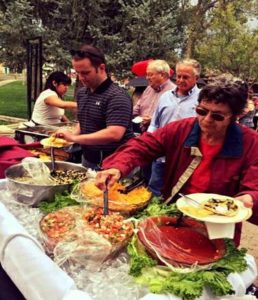
- This past weekend, the HU Office of Outdoor Life organized a trip to Bandelier. I heard a great time was had by all. Some photos of the students who made the hike:
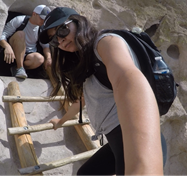
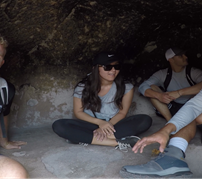
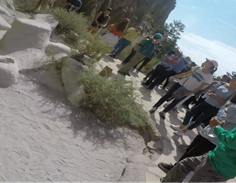
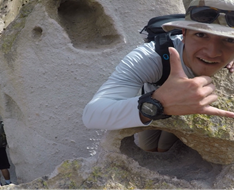
- On Monday evening, Joan and I welcomed the Chicago Scholars to the University Residence to share a meal. It was a pleasure to spend some time with these students and to talk with them about their early perceptions of HU. The students said so many very nice things about their professors and their overall experience here. Some photos from the event:
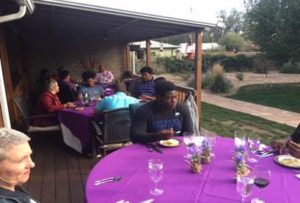
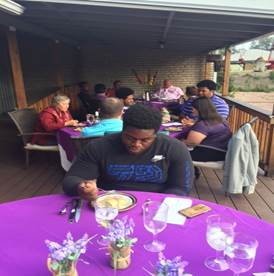
- We held our usual executive meeting on Tuesday. We started the meeting by discussing a brief article by Jeff Selingo. Here it is: https://www.linkedin.com/pulse/decade-ahead-promises-great-change-higher-education-jeff-selingo/. Selingo asserts in the article that he believes that deans will assume more and more responsibilities in the future and we discussed the historical and contemporary roles of the deans here at HU—what they have been in the past and what they perhaps could be/should be in the future. I think there was a general consensus that deans in general (not just here at HU) should either be given significant authority (and an equal measure of responsibility) to manage and lead or perhaps the structure should be flattened with the chairs reporting directly to the provost. Some institutions employ that kind of model. Those institutions are usually pretty small and in most cases, I think, the chairs at those institutions are really at least part-time administrators. It was a good discussion and the Provost described some preliminary ideas for the deans at HU. I served as a dean for many years and believe me, it is a very tough job. I thank Deans Lail, Taylor, Duran, and Padilla-Vigil for all they do. We moved on to other agenda items—our HLC Assurance Argument is now submitted and we have verification from HLC that they have it. We discussed a new advancement initiative—the Highlands University-Institute (more on that later) and we talked about next steps after our accreditation issues are successfully resolved. We also spoke about an initiative to send a group of HU students, staff, and faculty to assist those impacted by the recent hurricane in Texas. We’ll also be sending down a photographer to capture the efforts of our team. This initiative is being led by Dr. Beth Massaro, the 2017-2018 Leadership Fellow working out of my office. I should note that she is doing quite an excellent job—taking on tough tasks and getting things done. A photo of Dr. Massaro who I predict we will all be working for someday:
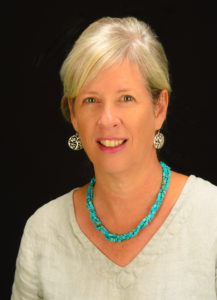
There was a very nice segment on KRUE news about our efforts to assist hurricane victims. I caught the video segment on the news last night. Here the story:
LAS VEGAS, N.M. (AP) – A state university in New Mexico is sending a 40-member team of faculty, students and staff to Texas to help in the wake of Hurricane Harvey. The team is led by Beth Massaro, a social work professor who says “there’s been a tremendous response” from within the university. Massaro says the team will travel Sept. 27 to the coastal community of Rockport, Texas, to volunteer at donation centers, help with cleanup efforts and other provide other aid. Massaro visited Rockport after the storm and she says damage was staggering with many homes and businesses destroyed and numerous snapped-off utility poles and downed trees. She says the team will camp on the property of a Highlands professor. New Mexico Highlands is headquartered in Las Vegas, New Mexico.
- Our Office of Student Recruitment will soon be hosting our first HU Roundup Day. This event is for current high school seniors in our area and the various activities on that day are designed to inform prospective students of the many advantages of a great HU education. A number of local high schools will be participating in this event. We are starting the recruitment process much much earlier than years past and that is a good thing. Our recruiters have been true road warriors lately—here they are recruiting at the state fair:
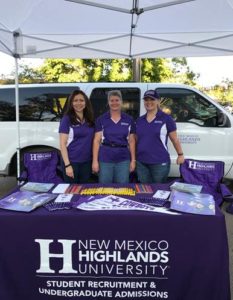
HU will also be sponsoring as very special recruitment event at the Rio Mora Refuge. High school students from Robertson, West, Mora, and several Albuquerque schools will spend a day at the Refuge working on STEM related activities and, of course, learning about the many advantages of a great HU education. Thanks to all who made this happen.
- Thursday was a busy one beginning with the Cowgirl Way luncheon at 12:30. It was so nice to see our coaches and Cowgirl athletes there and the strong support we’ve had over the years from Southwest Capital must also be noted. Thanks to Mr. Mike Melton for his ongoing support. Two of our Cowgirl athletes received scholarships courtesy of Southwest Capital and we also gave a special award to Ms. Tina Cordova for her ongoing support of HU and our Cowgirl teams. Later, I attended a sneak peak of the Northern New Mexico Painter’s Show in Kennedy Hall. It is absolutely fabulous and I encourage everyone to visit that show. Even later, I attended the H-Club Banquet where I met the new H-Club officers and honored several new recipients of H-Club awards.. A photo from the H-Club banquet:
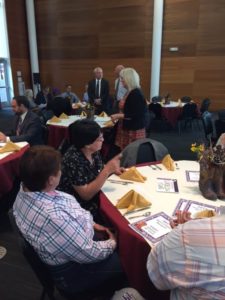
- Friday will be a busy one beginning with the President’s Homecoming Coffee, an Alumni Board meeting, participation in the West La Vegas homecoming parade, the Homefield Advantage reception and silent auction, and finally, the Mike Super performance. I hope to see many of you at these events! I also hope to see you on Saturday for our Homecoming parade, the tailgating event in the Industrial Arts parking lot, the recognition event honoring Chairman Sanchez and Patricia, the football game at 1:00 p.m., and or the Alumni Honors BBQ.
- Reminders:
- Power of Service Receptions on September 28. Morning reception at 8:30 a.m. Afternoon reception at 1:00 p.m. RSVP to Dr. Carol Linder.
- HLC visit: November 6-8. There will be no travel by executives on these dates without special approval by the President.
- HLC Update: On Monday, the HLC received our Assurance Argument. It was on-time and complete in every respect. That was a huge accomplishment. Thanks to all who contributed to this effort.
Greetings colleagues. A brief update for the week of September 4-September 8:
- One of HU’s strategic goals is technological advancement and innovation. There are many facets of that goal including instructional initiatives (using good technological tools to improve learning) as well as using technology to improve our basic business practices and processes. Over the last year or so, we have done work in both areas. In regard to the latter, for example, our student recruiters use a product called Slate. Using that product, our recruiters can tailor specific messages to targeted prospective students in an efficient way. This is the modern approach to student recruitment. I am also pleased to note that we purchased this solution by restructuring the budget in Strategic Enrollment Management. Thus, it did not require any new resources. This overall approach is likely the way forward at HU. We must take a careful internal look at how we are spending the resources we have and then reallocate resources to improve our outcomes. The “additive approach”—-somehow finding new money to do something new—is unlikely in the current fiscal environment. Our Advancement colleagues now use a product called Raiser’s Edge. Raiser’s Edge is the fundraising sector’s gold standard platform. This tool will allow HU to better identify patterns in giving, connect donations with specific appeals, and integrate several solutions that previously had been tackled separately – events, online giving, integrated payments. Additionally it has a tablet friendly view. If any of our advancement staff are visiting other cities and have unexpected free time, they can quickly look up details on local donors, and take notes after the meetings, so that nothing is forgotten. We are also bringing on other new tools that will hopefully result in efficiencies and improved overall performance. Using these tools, we are employing “technology to support quality, efficiency, and innovation in daily operations” as noted in our strategic goal.
- At HU, we have a strong commitment to serving our students in all locations. Our students who study at Center locations and or take HU online classes sometimes find it difficult to connect with various people and offices on campus and as a result, they are sometimes frustrated. That is totally understandable. The truth is, as many universities look beyond the traditional confines of their brick and mortar campuses to serve more students, there can be challenges associated with providing those students with everything they need when they need it. Technological solutions can sometimes help, but in some cases, a student just needs to talk to a real human being who can give them information or help them solve some problem. Today, we are searching for a staff member to do just that. This individual will be tasked with assisting Center students with any problem they have with any of our HU offices—financial aid, the registrar, the business office, etc. If an issue cannot be resolved quickly for some reason, this new staff member will take responsibility for assisting the student to resolve it rapidly, efficiently, and without multiple phone calls, emails, etc. The staff member will serve as a kind of “ombudsperson” to improve our customer service and assist students who so often are leading very busy and demanding lives. I should also note that, once again, this position is funded with salary savings resulting from a reconfiguration of Center personnel…we did not have to find new money to do this. At least to start with, this new staff members will report to both Provost Gonzales and VP Martinez since the issues our Center students typically have are in both of their domains.
- Last Saturday evening I joined an enthusiastic group of cowboy poetry and cowboy literature devotees in celebration of S. Omar Barker. Mr. Barker graduated from Highlands and worked here for a bit. He was also a solider, a legislator, a rancher, and held many other jobs, but he is probably best known as a poet and short story writer. A number of Omar’s relatives were at the event. The crowd heard several of Omar’s poems and anecdotes. Everyone also enjoyed a few musical numbers—Omar’s poems set to music by cowboy songster Andy Hedges. Andy is really a talented guy…check out his website: https://andyhedges.com/. A photo of Mr. Barker, the attendees at the event last Saturday evening and Mr. Hedges performing a song:
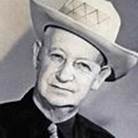
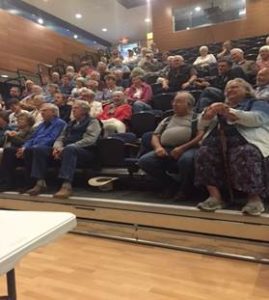
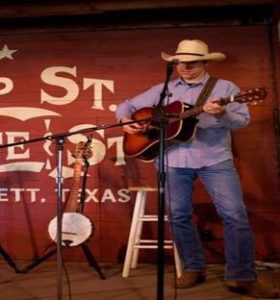
Here’s a few lines from one of Omar’s poems titled Curly Wolf College. I wonder if he was thinking of Highlands when he wrote it:
I went up to this college, but I didn’t stay there long,
For they asked a heap of questions and my answers was all wrong.
At least that’s how they figgered, like them college fellers do,
But I brought a prof back with me just to spend a week or two
A-ridin’ on the rancho with a hoss between his knees,
Where the wolves is wild an’ curly and the kiotes all got fleas.
About this here perfessor I won’t say no word unkind,
For he packs a heap of knowledge in that thing he calls his mind;
But now my lack of learnin’ don’t seem near so woebegone—
At least I know which end to put the horse’s bridle on
- On Monday, Joan and I drove to Taos to see the Cowgirl soccer team compete. Our team is competing in Taos while Sanchez Field is being redone. The soccer field in Taos is beautiful—really a world class facility. It was a good game with our Cowgirls coming up a bit short in the end (3-1), but the contest was well played and fun to watch. I particularly appreciated seeing such a nice crowd of HU students, staff, and faculty at this out of town game. I know our student athletes appreciated it as well.
- I had an early start on Tuesday when Juli Salmon, Margaret Gonzales, and I were on KFUN to talk about this year’s Homecoming. Tuesday was busy one with an HLC meeting, student and community speeches in light of the recent DACA decision, and later that day an open community forum focusing on our accreditation. The community meeting was small, but there were many good questions.
- Congratulations to Collins Kurui, one of our very best student athletes. Collin was recently named a “National Athlete of the Week” by the U.S. Track and Field and Cross Country Coaches Association. Collins is coached by Coach Bob DeVries, our winningest coach here at Highlands. A photo of Collins:
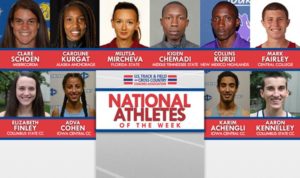
- On Thursday I held the first Coffee with the President at 9:00 a.m. in the SUB. About 50 people heard a brief overview of campus happenings and I fielded a few questions. As I’ve done in the past, I’ll do one of these each month. Later that same day, I was part of a conference call where we were informed that we had been selected to participate in an exciting partnership to improve the math performance of children in Northern New Mexico. There’ll be a press release about all that later.
- This is the time of year we all look forward to: the beginning of a new semester, pleasantly warm days, cool evenings, the smell of roasted green chili in the air and…Homecoming! I invite and encourage everyone from our Highlands community to get involved in the spirit of Homecoming, when our campus comes alive with new energy and excitement. Make plans to attend one or several of our Homecoming events over the next several days. Organize your team to create a float for the parade, hold an open-house reception in your department, reach out to alumni with whom you keep in contact, and join in the University-wide celebration of home and family. We have much to celebrate here at Highlands and I hope to see each and every one of you during the next week at an event as we welcome home our family. For a complete listing of events, go to:http://www.nmhu.edu/homecoming/
- Friday was a great day for HU. There was a wonderful gathering at the Trolley Barn, which is now named for two of HU’s best and strongest advocates—Dr. Joe and Martha McCaffrey. Their generous gift will forever be memorialized on our campus. We all owe them our deepest thanks. Later, we’ll hold another meeting to establish the plan for the renovation of Rodgers. At this point, the ground floor will consist of a Heritage Room (might be called something else) where we’ll display various artifacts noting faculty accomplishments and other important historical or contemporary activities associated with the campus. The vision here is to establish a small space where visitors can read material, view videos, and perhaps have a coffee or soft drink. Also on the first floor will be a board room—a real board room designed specifically for that purpose. As you probably know, we now hold board meetings in Kennedy and in many cases, we have to move things around (including, in some cases, valuable pieces of art). The room is not very quiet. It is hard to hear what is going on. It is often too warm. The technology has to be brought in. It just is not a good space for board meetings. If the current plan for Rodgers holds up, we’ll have a real board room and all of the problems I’ve noted will be solved. The plan is to also engineer a learning space on the first floor of the building. The notion that there are “academic spaces” and “non-academic spaces” on a campus does not really sit very well with me. Universities are about one main thing…teaching and learning…so bright lines differentiating functions are not really appropriate in my view. The thinking is that this learning space will be a top notch classroom with very good technology and other special features. It will be one of the “best” learning spaces on campus. I will be working with Dr. Ian Williamson and Provost Gonzales to establish some guidelines about how this space is scheduled. Should we, for example, make this space available to our newest colleagues, most senior colleagues, who? Again, I think (and hope) it will be a very desirable place to teach and learn. Administrative offices will be on the second floor of Rodgers. That’s the plan at this point.
Later Friday, Joan and I will attend the opening of the new show at Mayeur Projects, the new gallery on the Plaza. I should note that the owners, Christian Mayeur and Anne Poux, are also interested in working with Highlands on some exciting projects (e.g., visiting artists, possible exchanges with an art school in France, etc.). More on all that later. Finally, we’ll attend the Carnegie Under the Stars event—a celebration of the improvements in the Carnegie Library. HU is collaborating with Main Street de Las Vegas on this event. As you may know, I am on the board of Main Street. Finally, on Saturday morning we’ll drive to Golden, CO to see the Cowboys play. As is typically done in the RMAC, the President there will serve as our host during the game. I know several folks from campus are going to the game and I hope to see them there.
- This Week in Accreditation: On Wednesday, September 6th, the Board of Regents reviewed and approved the Assurance Argument, and Highlands submits all our materials to the HLC on Monday, September 11th, in anticipation of our November 6th-8th on site visit. Dr. Kempner and I would like to personally thank the campus community for all their efforts in drafting, proofreading, and providing documents for the Assurance Argument. This has been a truly collaborative effort, and the quality and thoroughness of the document reflect the dedication and the hard work of all sectors of the university.
SEPTEMBER 11—A VERY STRONG ASSURANCE ARGUMENT MAILED TO THE HLC—MISSION ACCOMPLISHED. NEXT STEP—CAMPUS VISIT ON NOVEMBER 6-8.
Greetings colleagues.
A brief update for the week of August 28-September 1:
- One of our Strategic Goals for 2020 pertains to community partnerships. It is axiomatic that as HU goes Las Vegas goes and vice versa. It is important that we work hard to be a strong community partner for many other reasons. In my view, it is really one of our responsibilities in the modern academy. The days of higher education being distinct from and disinterested in the greater society and the communities where they are located are long gone. The Ivory Tower has toppled. There is perhaps no better example of our commitment to community partnership than the work of Mariano Ulibarri in our LANL + NMHU STEM Lab. The outreach we do there ranges from maker lab session for local youth to a computer science club to rocketry to coding training and many other STEM activities. I particularly want to note that we will soon purchase and outfit a mobile STEM Lab (last item under Additional Planning below). This will be a trailer wrapped in some distinctive HU symbols. Among other things, the lab will visit local and regional K-12 schools to foster student interest in STEM disciplines and provide professional development to teachers. Take a look at this semester’s lineup. It is a long list, but I thought it was important to make certain everyone knows how hard we are pushing on this important outreach initiative. Well done to all who are working to make this happen, particularly Mr. Ulibarri who works under the ARMAS umbrella. His image appears below followed by this term’s activities:
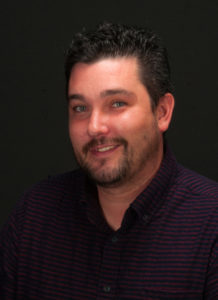 LANL + NMHU STEM Lab / Programs for Fall 2017
LANL + NMHU STEM Lab / Programs for Fall 2017
AFTER-SCHOOL K-12 Programs
K-12 programs at Hewett Hall will begin on September 18, 2017. Students will attend one of four weekly sessions tailored to their age/grade. Monday-Wednesday sessions will focus on age-appropriate, hands-on STEM projects in areas such as robotics, 3d printing, coding, digital fabrication, and rocketry.
- Mondays – 09/18-11/27 – K-2 Maker Sessions
- Tuesdays – 09/19-11/28 – 3-5 Maker Sessions
- Wednesdays – 09/20-11/29 – 6-8 Maker Sessions
- Thursdays – 09/21-11/30 – 8-12 Science Fair Think Tank and Lab
SPECIAL EVENTS for the COMMUNITY
- After-School Program Showcase – Friday, November 17, 2017 – K-12 students will showcase their work from the after-school STEM programs at Hewett Hall.
- Las Vegas Electric Light Parade – Saturday, December 2, 2017 – NMHU students from the Lighting the Way CS135 Learning Community will showcase their work from throughout the semester in the form of an interactive float for the parade.
- The Hour of Code – Saturday, December 9, 2017 – Last year’s Hour of Code event was held at ARMAS. More than 75 local students, teachers, and community members attended the event.
COMPUTER SCIENCE Programs for NMHU Students
Lighting the Way Learning Community CS135 – Mon & Wed – 11am-12:15pm
- Computer Science Club – Weekly Meetings – TBA
- Demos for the NMHU Native American Center – TBA
- Hewett Hall STEM Lab – Open hours for CS students – Tues & Thurs – 10am-3pm
INTERNSHIPS and STUDENT EMPLOYMENT
- CMS / Web Development Intern – Gavin Westberg (CS) will be working with Mariano Ulibarri to create a website to showcase schedules, activities, and documentation from the Hewett Hall STEM Lab. Approval has been given by Sean Weaver at University Relations to launch the site. Overall style will conform to NMHU’ Visual Identity Guidelines, and Mr. Weaver will vet all work before it is posted.
INTERNSHIPS and STUDENT EMPLOYMENT (contd.)
- STEM Lab After-School Mentor – Gideon Takor (MBA) will be working with Mariano Ulibarri to facilitate after-school programs and special events during the semester.
- Las Vegas, NM EDC – Khalifa Alenazi (MBA) is currently working with Bill Hendrickson on business and marketing projects for the EDC.
ADDITIONAL PLANNING for Spring & Summer 2018
During Fall 2017, we will begin planning programs for the spring semester and summer term of 2018. Planning will include collaboration with the NMHU Native American Center, after-school programs for the spring semester, summer STEM day camps, and future off-campus K-12 STEM outreach programs.
TIMELINE for MOBILE STEM LAB (enclosed trailer)
During the first half of the fall 2017 semester, we will be purchasing all the equipment and supplies included in our current LANL budget to outfit both the Hewett Hall STEM Lab as well as an enclosed trailer for off-campus outreach. By the second half of the semester we hope to have purchased the trailer and set it up with an NMHU / LANL wrap. Sean Weaver has asked to approve the final design for the trailer wrap before it is installed.
Another example of HU’s commitment to community outreach took place last Saturday at the Welcome Back Fiesta. Community members (and their kids) were invited and many participated. A photo from that nice event: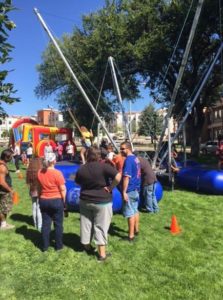
- HU is fully committed to serving all of our students including those at Center locations. Two great examples of this are the Net Tutor program, which is available to all of our students 24/7. We receive reports from Net Tutor every term and the last report we received revealed that HU students spent 5,192 minutes accessing the service with about a 50/50 split between Las Vegas campus students and Center students. Net Tutor is a great way for all of our students to access tutoring services and particularly handy for Center students who are often on the go, have demanding jobs, an active family life, etc. For Center students, they can access Net Tutor any time…any place. I should also note that the most common Net Tutor services accessed by our students were computer science, accounting, composition, and statistics. Another way we reach out to Center students is developing informational videos about services and then pushing them out to everyone. Here’s a video featuring April Kent. We recently completed this loop about services at our library: https://www.youtube.com/watch?v=N1hL-EyOL60&feature=youtu.be. The bottom line—we seek to serve all of our students in all locations including online students. Technology is the most common way to do that and we are investing resources to make certain all of our students are supported.
- I am very pleased with the efforts of so many people to make such good progress relative to our strategic goals and frankly, I can’t wait to demonstrate to our HLC visitors what we’ve done. There’s a lot to show. Here’s a few brief videos about some—really, only a few—of the accomplishments we’ve made over the last year or so: http://www.nmhu.edu/mission-accomplished/. Of course, we’ll make certain our HLC examiners see this.
- A report about what is all too apparent to us— this from the Santa Fe New Mexican (here’s the link to the article if you care to download it—I’ve highlighted in red several key sentences and phrases). Go to:http://www.santafenewmexican.com/news/education/n-m-among-states-with-largest-reductions-in-higher-ed/article_890fce06-397e-5128-9d04-c2b5f656707f.html).
New Mexico is among the states that have seen the steepest reductions in higher education spending since the national recession, a new report says, investing nearly a third less per student in the last fiscal year than it did in 2008. The report, by the Washington, D.C.-based Center on Budget and Policy Priorities, a nonprofit research institute, shows a nationwide trend of declining public funding for colleges and universities as tuition rates steadily rise, placing a heavier burden on students to help fund school operations. The research center released the analysis last week, just months after many public colleges and universities in New Mexico once again raised tuition rates and trimmed programs and staff in response to a recent series of state spending cuts. Earlier this year, a student loan management company found that New Mexico has, by far, the nation’s lowest tuition rates for in-state students attending public schools. The same organization, Austin, Texas-based Student Loan Hero, also ranked the state second in the nation for the economic benefits of an academic degree, saying a New Mexico graduate’s average return on investment is 150 percent within five years. But without state policy changes, the D.C. nonprofit warns, higher education — and its benefits — will become further out of reach for a growing number of young people in New Mexico and across the nation, particularly minority students and those from low-income families. “At a time when the benefit of a college education has never been greater,” the report says, “state policymakers have made going to college less affordable and less accessible to the students most in need.” James Jimenez, executive of New Mexico Voices for Children, an Albuquerque-based nonprofit that advocates for child well-being, agreed. “We have made it much more difficult for them to build the sort of skills they need to compete in this economy,” he said in a statement in response to the new report. The report doesn’t take into account New Mexico’s lottery scholarship, which has covered most tuition costs for tens of thousands of New Mexico students attending in-state schools for more than two decades. Because of declining revenue from lottery ticket sales, this year’s scholarships will cover only 60 percent of tuition, forcing about 26,000 students in the program to pay more out of pocket. New Mexico ranks eighth among states for the rate at which its per-student funding has dropped since before the recession, the report says, with funding levels adjusted for nearly a decade of inflation. When it comes to the dollar amount per student, New Mexico’s funding decline between 2008 and 2017 is second-highest at $4,509. That number is topped only by Louisiana, at $5,350. The nationwide average higher education cut in that time period is $1,448 per student, or 16 percent. Only five states have seen an overall increase in higher education funding since 2008. And while most states did increase funding over the last school year, the report says, New Mexico, which has grappled with a fiscal crisis, is among more than a dozen that continued to make cuts. The state cut higher education spending by about $50 per student in the last fiscal year, the report says, and schools raised tuition by an average of about 2 percent, or $131 per student. Public schools also are cutting jobs and programs and increasing class size, the report says. It cites the elimination of 120 jobs at New Mexico State University, as well as reductions in employees’ benefits. NMSU officials did not respond to requests for comment. University of New Mexico Interim President Chaouki Abdallah said in an email that UNM also has made “severe internal cuts and adjustments.” “It is true that New Mexico, like many other states, has reduced its per student funding because of the various pressures on the state budget,” Abdallah said. “Tuition increases have made up some of the reduced funding but not all of it.” Meanwhile, he said, “the costs of teaching, benefits, physical infrastructure, compliance, etc.” have continued to increase. Still, Abdallah said, New Mexico is one of the few states where tuition remains lower than the state appropriation for each full-time student. The Center on Budget and Policy Priorities recommends that states raise revenue for colleges and universities by “repealing ineffective tax deductions, exemptions and credits, rolling back past years’ tax cuts or raising certain tax rates.” Legislative efforts in New Mexico to increase revenue by raising taxes aren’t likely to succeed under Gov. Susana Martinez, who has vowed to veto any such measure. In the 2017 legislative session, Martinez vetoed about half the spending in a budget passed by both chambers of the Legislature that required a companion package of tax and fee increases to remain balanced. She also vetoed the tax package. Included in the spending she vetoed was the entire higher education budget. During a special session to come to an agreement on the state budget, Martinez supported a massive overhaul of the state’s gross receipts tax system, and she signaled that she would be open to raising some taxes as part of a broader reform plan that eliminates loopholes, lowers overall tax rates and is more accommodating to businesses. Lawmakers rejected a hefty tax reform measure, however, saying the short special session was an inappropriate time to address the issue. Lida Alikhani, a spokeswoman for the state Higher Education Department, defended the state’s level of support for colleges and universities, saying in a statement that “New Mexico invests a higher percentage of the state budget into higher education than many other states across the nation. ”She added, “Our higher education institutions are extremely important to this administration and we are proud that our colleges and universities are working to become more efficient.”
10 states with sharpest reductions in spending per student since 2008:
- Arizona: 53.8 percent, or $3,540
- Louisiana: 44.9 percent, or $5,350
- Illinois: 36.9 percent, or $2,407
- Pennsylvania: 34.2 percent, or $2,533
- Alabama: 34.1 percent, or $4,145
- Oklahoma: 34 percent, or $3,294
- South Carolina: 33.6 percent, $3,131
- New Mexico: 32.7 percent, $4,509
- Delaware: 27.1 percent, or $2,413
- Kentucky: 26.4 percent, or $2,832
In many ways, the key point in this article is the statement that, “New Mexico invests a higher percentage of the state budget into higher education than many other states across the nation.” That is absolutely, definitively, and without question true. And…that is precisely why we are such a low tuition state. Most of our resources come from the state and we are very much an outlier in respect to that level of state funding. But in our particular high-state-support/low student tuition situation, when state support goes down, there is really only one major way to make up the deficit—increased tuition. Given the dynamics at work now, this is the critical question…do we want low tuition and high support from state government or higher tuition with less support from the state? At the core, it is really that simple. It is common to hear suggestions that the deficit can be made up by making cuts—often referred to as “strategic cuts”—but my experience suggests that it is virtually impossible to do that if we are talking about significant amounts of money. For the most part, our work is extremely labor intensive (the Baumol’s Cost Disease idea) and you can nibble around the edges with cuts all day, but it does not take very long before you get to the really big-ticket items—the people who work there. My takeaway—as a nation, do we think we should collectively support high-quality and low cost public higher education or do we think the costs should be borne by students? Ultimately, we have to come to grips with that question. In my view, there are not really good guys and bad guys in all this. Those in state government do not want to burden students with debt any more than we do. The issue is…what do we, as a nation, think we should do all about this—-(relatively) high state support or (relatively) high student debt? Who should pay? My two cents.
- The EMT met on Tuesday and we kicked off the meeting with a discussion about innovation in higher education. We read this article: http://washingtonmonthly.com/magazine/septemberoctober-2016/the-sixteen-most-innovative-people-in-higher-education/. Some questions we grappled with—-Is it always a good thing to “innovate” and in our work, what does that really mean?, Are some new leaders too interested in “innovating” mostly to say that they have done that and can add to their reputation?, Are we innovating too much?, Too little?, What is the situation at HU in regard to innovating? If we think there should be more innovation here, what is getting in the way of that? How useful is it to assert that an organization could be more innovative if only someone else would change their behavior? What about our behavior? It was a good discussion with lots of food for thought. We also discussed the status of the HLC assurance argument, plans for homecoming, recent victories in advancement, and a few other matters including the possibility of sending an HU contingent to the Houston area (or some other area impacted by the flooding). This year’s Leadership Fellow, Dr. Beth Massaro, is thinking through the various issues associated with sending an HU group to Texas. There are many moving pieces—where will our students stay?, what will they do to really help and not get in the way?, etc. If you have thoughts, ideas, and or suggestions about this, please feel free to contact me and or Beth (bmassaro@nmhu.edu). We also discussed a modest new initiative involving several retired and current professionals in the United States State Department. Several retired State Department professionals now live in Santa Fe and they are interested in working with HU and our students in some fashion. These individuals have had illustrious careers in the State Department and have held very responsible positions. They have worked in locations around the world. One individual would like to do a few lectures here on campus and perhaps work with our Santa Fe students on their writing. Another sponsors an annual meeting in Santa Fe where there is quite a high level discussion of various world events and topics. We are thinking about sending dome of our students and faculty to that meeting. A third person is an Executive in Residence at UNM and is interested in coming up to our campus to talk to students about careers and internships with the State Department. We are thinking about rolling all this up into some type of modest HU-U.S. State Department Initiative. Again, Dr. Massaro is working on all this. Please let me or her know if you’re interested in learning more or participating in some way.
- Some may have seen an article in a local news outlet about HU and the RMAC conference. Basically, the article suggested that given some of our recent challenges including those associated with the delays associated with the field (mainly due to rain), perhaps the RMAC should dissociate themselves from us. What an argument. Taking care of things with private money instead of relying on the state is…or should be…a very good news story. And the rain? Well, I am ultimately responsible for everything at HU, but I cannot do a thing about the weather. I’ll file this one under no good deed goes unpunished. Well…the RMAC has weighed in. Here’s their response:http://www.santafenewmexican.com/opinion/my_view/we-choose-to-embrace-highlands/article_127d9aea-b529-5737-a7df-acd7bb81c8d7.html.
- Please consider getting a ticket to see Mike Super, an illusionist we brought to campus last year. He won rave reviews from our students. His concert (a new show…different from last year) is September 15 at 7:00 p.m. in Ilfled. Tickets are $12.00—no fee for HU students. Advance tickets are available beginning Sept. 1 at the university’s KEDP radio station ticket office, Studio 103, 901 University Ave., Monday – Friday 10 a.m. – 12 p.m. and 1 – 5 p.m. Or call 505-454-3238. This event is brought to the campus by the Arts@HU series and funded by the Campus Life fee.

- We are once again supporting the “HU: Learning Happens Here” program. Staff members are invited to enjoy a free brown bag lunch and learn something new from an HU staff or faculty member. The first session of the fall term will be September 26 from noon-1:00 p.m. Participants will learn some basic Tai Chi and Chi Kung movements from Dr. Ian Williamson. This if first come-first served. Interested staff members can RSVP to the number/email below. The health benefits of this practice are quite well established. Sign up early—there are only ten spots. Many thanks to Dr. Williamson for doing this.
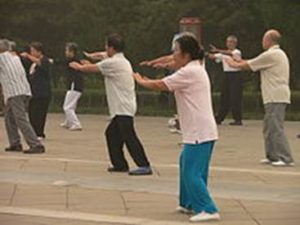
When: September 26, 2017
Time: Noon – 1 p.m.
Faculty Presenter: Ian Williamson, Ph.D.
Topic and Description: Chi Kung: Taking a Moment to Relax
Tai Chi and Chi Kung are ancient martial and movement arts of China. These movements are designed to build chi or energy in the body, expand the breath, and reduce stagnation and blockage. They are also being used in older populations to improve balance, reduce blood pressure, and maintain health more generally as well. This session will be “hands-on” where staff are welcome to practice the relaxation techniques by engaging the Chi Kung movements of the Bear and the Crane, while focusing on some of the basic concepts of relaxation and energy building.
Location: SUB 321
Join from PC, Mac, Linux, iOS or Android: https://nmhu.zoom.us/j/474320730
Brown bag lunches will be provided for you to enjoy. RSVP is required.
RSVP to:
Cathy Santistevan
Phone: 505-454-3048
csantistevan@nmhu.edu
- On Thursday, I welcomed an enthusiastic group of high school counselors, tribal officials, and staff from community colleges. This is an effort to more powerfully connect with the various professionals who make recommendations to high school students and transfer students looking at college and universities. It was a great meeting…well organized…and upbeat. Many thanks to the professionals in Strategic Enrollment Management for organizing the event and working so hard to build our enrollment. When I arrived two years ago, I learned we owned an expanded golf cart we had used for campus visits, parades, and the like, but I also learned that it was not working. It was basically sitting in storage. I asked Dr. Martinez to get it up and going if it was possible to do so and he did. We had this vehicle at the counselor’s event. It really looked great. A few shots of the HUmobile:
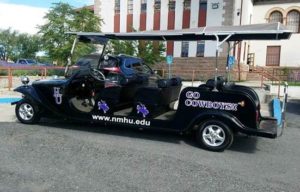
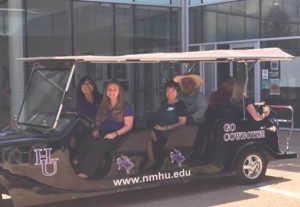
- The HU Cowboys played their first football game of the season. Our opponent was Dixie State. Due to delays in construction of Sanchez Field, we played the game at West. There was a great turnout for the game and a very nice vibe. Lots of cheering, shouting, and plenty of Cowboy pride in evidence. And…we won the very exciting game.
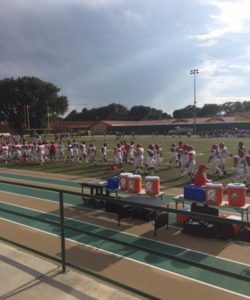
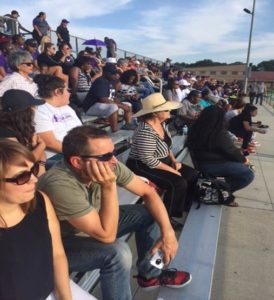
- This Week in HLC Accreditation: On Tuesday September 5, 2017, there will be a community forum at 5:30 in the SUB Ballroom on the HLC Probation Areas and the Assurance Argument. On Wednesday September 6, 2017, there will be a special Board of Regents meeting for the Regents to review the final Assurance Argument before submission. The University is still accepting comments and corrects to the Assurance Argument, at http://www.nmhu.edu/accreditation-information/assurance-argument/. All comments must be given to Brandon Kempner, bkempner@nmhu.edu by Thursday September 7th, at 5:00 PM, for inclusion in the final document we provide to the HLC on September 11th. A new draft of the argument, including all revisions up to this point, will be posted on Friday afternoon, so please proofread the most recent version.
Greetings colleagues. A brief update for the week of August 21-25:
- Two of our Core Values in the Vision 2020 document are excellence and responsiveness and I recently came into contact with one of our new students who talked to me about his HU experience (thus far) and how it relates to those particular values. This student is a new freshmen from a small town near Las Vegas. I asked him how things were going so far and he told me about missing a class and being surprised by a phone call from the instructor inquiring why he had missed. There was apparently a legitimate reason for his absence. They discussed that a bit and then his instructor asked him about how he was doing on the first class assignment. The instructor encouraged the student to send him a draft, which he did. The student was surprised and pleased that he was receiving such close attention by this instructor and the university in general. That level of attention and responsiveness is a key to excellence at HU. That excellent level of attention and responsiveness simply does not occur on all campuses across the nation. In this case, at least, it did. Excellence does not occur by chance. I know that. Responsiveness takes extra effort. I know that too. I thank my good colleagues who embody these core values in their daily actions.
- In a somewhat similar vein, a Santa Fe Center student contacted me this week to compliment the attention she had received by those at the Center as well as people on campus. Her positive comments were unsolicited and I could tell….from the heart. There was some issue with her financial aid and it was causing her great distress. Her issue was immediately handled by our good colleagues in Santa Fe and on campus—she particularly commented on the prompt attention she received from our Registrar. Well done to everyone who works hard to improve our service to all students including Center students.
- Last Friday I met with several board members of the H Club. We met at the University Residence and had a good discussion about how we could work more collaboratively and improve overall communication—all for the greater good of HU and particularly HU athletics. It was a very good meeting and we ended with a renewed commitment to work together and improve HU athletics. I thank the members of the H Club for everything they have done, are doing, and will do to assist HU.
- Last Saturday, a nice group of HU students, faculty, and staff did a Hermit’s Peak hike. Many thanks to everyone at the HU Outdoor Recreation center for organizing this event. A picture at the start of the hike and a second obligatory photo at the summit—a few less in the summit photo, but I am no one to talk. I did not do the hike.
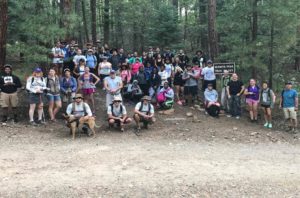
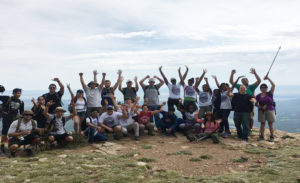
- On Monday morning, I had an early meeting in Espanola with officials from LANL, various elected officials, and Ms. Janet Napolitano, former Governor of Arizona, former Secretary of Homeland Security, and current President of the UC system. We had a good discussion about how the Lab could more powerfully work with HU and other Northern New Mexico institutions of higher education. A photo from the meeting:
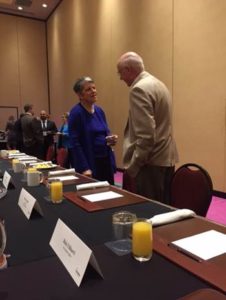
- Due to my meeting with LANL, I missed the eclipse viewing on our campus. The weather in Santa Fe was overcast so nothing was peeking through. But, the viewing celebration in Las Vegas was quite a success thanks to leadership of Dr. Joe McCaffrey and his team. A nice photo from that event:
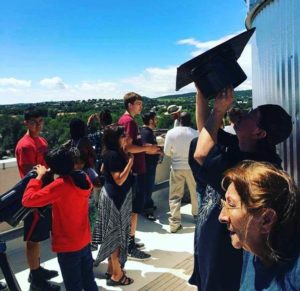
- Wednesday was a long one—-a community meeting at LANL beginning at 7:30 a.m. followed by a meeting in Santa Fe with a variety of active and retired folks from the U.S. State Department followed by a Welcome Back Dinner sponsored by the Native American Club. The individuals I met from the State Department are interested in getting involved with HU and our students and I am optimistic that something will come of that. Dr. Beth Massaro, the Leadership Fellow in my office this year, is working on this initiative. More on all that later.
- Please encourage your students to attend the Welcome Back Fiesta this Saturday from 1:00-6:00 in Melody Park. There will be bands, food, and fun activities all afternoon. As one component of HU’s commitment to the Las Vegas community, this is a campus and a community event. All are welcome. It should be fun.

- This Week in HLC Accreditation (from Dr. Kempner): The University is accepting comments to include in our Assurance Argument. You can access the link to submit a comment at http://www.nmhu.edu/accreditation-information/assurance-argument/ .
We are polishing up the Assurance Argument—well ahead of the deadline. I have been involved in accreditation matters many times over the years and this is the earliest—by far, the earliest—that I’ve been at any institution this far ahead of the game. There will be additional opportunities for people to provide input, but we are in good shape in my humble opinion.
Greetings colleagues. A brief update for the week of August 14-18:
- As everyone knows, the NMHU Vision 2020 document describes four values guiding our actions. These values “drive” the institution in regard to budgets, curricular areas of emphasis, and essentially are the things that matter most to us. The things we keep in front of us every day. Those values are excellence, accessibility, responsiveness, and diversity. For me and for us as a community, these are not mere slogans to put on a banner. They truly guide is in all things. On Tuesday, we held our Convocation and heard some very nice speeches from our provost, an HU student, and others. I elected to focus my remarks on issues of human diversity. My remarks are attached (above) if you’d care to read them.
- HU is fully committed to serving all of our students…those on our home campus, those at our Center locations, and those talking classes online and Ms. Latasha Burbank is committed to make certain those students are well served. Latasha likes to say, “I am Arizona raised and New Mexico adopted”. From cactus state to chili state, her home roots will always be the beautiful scenic Navajo Nation. As a proud Highlands alumni and community member of Vegas, she have launched her career with HU CARES as the Center Advocate & Education Coordinator with full devotion and enthusiasm. She received a Bachelor of Arts in Criminal Justice Studies, now pursuing a Master in Social Work (part time) at Highlands. Her objectives as the Center Advocate will be developing and implementing cultural sensitivity and diverse programming to reach each NMHU center site. A photo of Ms. Burbank:
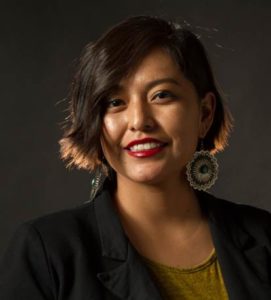
- Monday began early with an 8:00 a.m. welcome to the students and families at our last new student orientation. I sat with a very nice group of new students and learned a bit about their hopes and dreams and their expectations for their time at HU. Anyone who is pessimistic about the nation’s future should sit with these young people for a bit. They are energetic, optimistic, and eager to do good things for themselves and the world. A photo from the very well organized event:
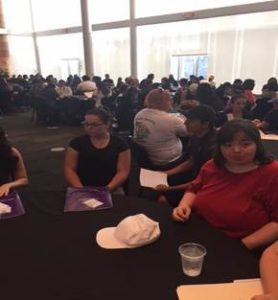
- Later that same day, I attended the Global Leadership meeting in Albuquerque and heard Senator Udall speak about the importance of maintaining strong global connections to other nations in order to strengthen the economy and maintain good relationships with our overseas neighbors. It was an inspiring speech and well worth the drive to and from. A photo from that well attended event:
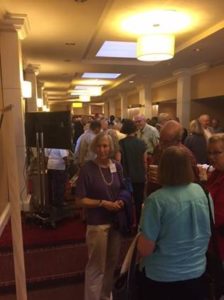
- This semester, the Big Ideas reading groups will read Hillbilly Elegy by J.D. Vance. Dr. Williamson will send out a call to the faculty and those interested will receive a copy and at some point we’ll gather for a discussion. The date for the discussion will be set soon. The review of the book in the New York Times: https://www.nytimes.com/2016/08/11/books/review-in-hillbilly-elegy-a-compassionate-analysis-of-the-poor-who-love-trump.html.
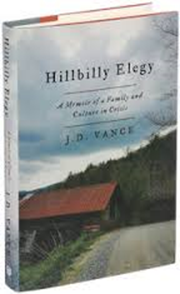
- Also on Tuesday, Brandon, Caro, and I were on the phone with the Chair of our HLC team. We discussed some details of the upcoming visit, what meetings the team wanted to have, who the team wanted to invite to the meetings, and other logistical matters. Our team leader, Dr. Gar Kellom, has not received our assurance argument yet (we have several weeks before we must send it to him), but he congratulated us on the transparency of our HLC website, the frequent meetings we have held to update the community on our work, and the additional efforts to communicate progress via these weekly messages (which apparently, he reads). As we get closer to the visit, we will provide the community with a finalized version of the itinerary.
- This week I learned of another great HU faculty member’s successful efforts resulting in a new publication. Dr. Erika Derkas is back from her sabbatical and shared her latest piece of scholarship with me—a book she co-edited and published by the Feminist Press. Erika also contributed two articles for the book. Well done. Very well done. The jacket of Dr. Derkas’ new book:
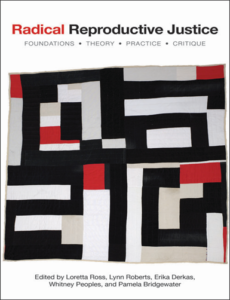
- Thursday was a busy one on the road. I attended the all Pueblo Council of Governors meeting in Albuquerque where Dr. Martinez, Ms. Julia Geoffrey-Lementino and I addressed the Governor’s and told them about the many advantages of an NMHU education. HU was the only university in attendance at the meeting. I had several good sidebar meetings with Governors who expressed high interest and support of HU and our efforts to bring more Native American students to the campus. Later on Thursday, Joan and I attended the ribbon cutting for the new Community Center for Indegenity at Melody Hall. This initiative is designed to create a learning-living experience for Native American students as well as those interested in learning more about Native people and customs. In my view, this is an important initiative on our campus and I thank the individuals who helped make it happen, particularly Dr. Rebecca Moore, VP Martinez, Professor Eric Romero, Ms. Yvette Wilkes, and Ms. Julia Geoffrey-Lementino.
- We have to finalize a few contracts so I cannot be more specific at this point, but the Arts@HU lineup is about set for the 2017-2018 academic year. Things will kick off with a welcome back fiesta in Melody Park. The lineup will continue with an illusionist, some comedians, a female mariachi group, an award winning country singer, a group of violinists who play both classical and hip hop, and a ballet. Well done to Ms. Donna Martinez and Dr. Blea for making all this happen. These performances are supported by the NMHU Campus Life fee.
- Tractor Time. I imagine everyone has devised their own way or ways to defuse a bit, get more centered, and more grounded. Sometimes, our daily lives are pretty hectic and we need to find a way to achieve some balance. For me, I refer to this as Tractor Time. When I worked at Truman State I had a pretty demanding job and needed some way to come down a bit. We owned a beautiful and rather isolated pre-Civil War farmhouse at the very end of a very long and very dusty gravel road…here it is…
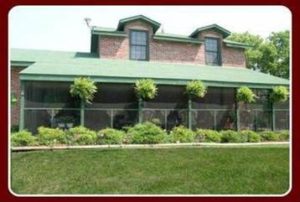
…and some land and when I needed some down time, I often fired up the John Deere. My favorite activity was cutting weeds and brush so I hooked up the cutter, put my ear buds in, and away I went. You can’t beat Lucinda Williams while cutting down weeds in 95 degree heat. I mean, it just doesn’t get any better than that. It was just the ticket—you had to pay attention a little bit (there are many tractor accidents on farms—fortunately, I left the farm with all digits intact), but it was basically pretty mindless. You cut a path in the weeds. Then you turned and went back the other way until the pasture was done. It was also very fulfilling—there was a field of brush and weeds—sometimes six feet tall—and you’d cut it all down and in the end, it looked nice and tidy. For a few days, anyway. Tractor Time. I’ve lived other places and had other jobs where Tractor Time took different forms. For example, in Virginia we lived on the Virginia Tech golf course and there were dozens and dozens of deer there. In that job and in that location, Tractor Time amounted to taking a run along a certain route and along the way, seeing how close I could get to a deer. They were pretty domesticated. They weren’t hunted there and there was a covenant against loose dogs so the deer were not bothered much at all. Except for me. I could actually get pretty darn close. Well, I no longer have a farm and no longer live on a golf course with domesticated deer so now, Tractor Time means cranking up my music and taking a short and leisurely ride out into the wilderness. I probably do this once a week or so…as needed, dependent on how hectic things are. If I am lucky I see a deer or an antelope or maybe even an elk, but the real goal here is to get centered so I can get back to work. Some photos from my most recent Tractor Time…New Mexico style. The photos were taken this week. Do you recognize the place?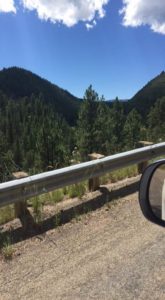

Greetings colleagues. A brief update for the week of August 7-11.
- On Monday, I had a phone conversation with the chair of our HLC team. We discussed travel arrangements, the various meetings they will hold while on our campus, and the status of our assurance argument. He did mention that the team would primarily focus on the areas of concerns noted by our accreditor. That is to be expected and we will be prepared for that. On Friday, Dr. Anthea Sweeney, our HLC Liaison, visited the campus. Brandon Kempner and I gave her a brief tour of Las Vegas and she then met other groups on campus including an address to the full faculty and staff.
- On Tuesday, I and several other HU folks attended a BBQ at the Charles R Ranch. The guests of honor were members of the football team, our coaching staff, and a few family members who accompanied their sons for move-in. I met each player and had at least a brief word with each. I really liked the vibe of these student athletes and am happy to even be a small part of their dreams. A few photos from the event:
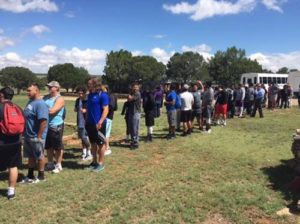
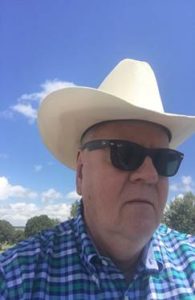
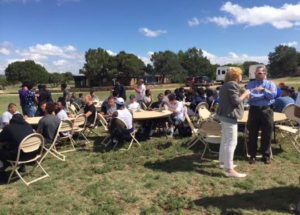
- I imagine that some colleagues read about our very high national ranking from the Brookings Institute. HU moves many students out of poverty…and we do it better than most. The article was written by Margaret McKinney.
Las Vegas, N.M – New Mexico Highlands University is one of the leading colleges in the country for boosting its students’ social mobility, according to the Brookings Institute.
In a study published in July 2017, the Brookings Institute ranked Highlands 19th among 342 four-year public teaching colleges nationwide that help push students up the income ladder upon graduation, especially those from low-income families. Highlands is among select colleges that succeed in promoting opportunity, which makes for a more dynamic and fair society, according to the Brookings Institute, a nonprofit public policy organization based in Washington, D.C. “As a nation, if we want to loosen the grip of intergenerational poverty, we must support institutions like Highlands that accomplish that goal and are successful ladders of upward social mobility,” said Highlands University President Sam Minner. “I’m very proud of our university for being recognized for this accomplishment. Join our HU family. Allow us the opportunity to help you achieve your dreams. Blast out of Highlands to lead a life of deep purpose and meaning, including a great job.” Minner said college graduates experience many positive outcomes beyond increased earnings, such as typically having better health, voting more frequently, and accessing social services less frequently. He said many studies show that higher education is especially important in helping students who are the first in their family to attend college break out of poverty. These students are a significant Highlands University demographic. “Graduating from college changes these first-generation students’ lives, but the benefit does not stop there. Frequently, this is the beginning of an intergenerational shift, with their children and grandchildren also graduating from some form of post-secondary education,” said Minner, citing his own story of being a first-generation college student whose daughter and son both achieved graduate degrees. “My story is not unique. Graduate from college and that sets the path and provides motivation for future generations to do the same. In my opinion, our nation should do everything possible to provide the opportunity of a college education to all our citizens, especially those who face daunting economic challenges,” said Minner, who earned a Ph.D. from the University of Arizona. Minner said moving students out of poverty is an enterprise endeavor that involves dedicated faculty, staff and administrators at Highlands, with alumni also playing an important role. “How every person at Highlands treats our students and how much they care about them is at the heart of any educational endeavor. Showing this by word and deed matters a great deal,” Minner said. Minner said he thinks he and many of his colleagues at Highlands work at the university in part because of a shared belief that the work they do promotes social mobility for students, changing their lives. The Brookings Institute used newly available tax data from the Equality of Opportunity Project at Stanford University as well as a number of other recent research studies to gauge upward mobility of college students. The Brookings Institution’s mission is to conduct in-depth research that leads to new ideas for solving problems facing society at the local, national and global level.
- On Wednesday, I drove to Santa Fe to update HED on our football field project. We are required to present projects for approval irrespective of the source of funds. It was a good and positive meeting with our colleagues at that agency. Now, even though we always welcome rain in Northern New Mexico we need a spell of dry weather to complete the project.
- On Thursday I delivered the State of the University Address. It is attached if you care to read it. I also enjoyed our keynote speakers comments on Thursday. Her talk was clearly better than mine. Afterward, I briefly looked around for what the current vibe is when it comes to assessment in higher education. I found an interesting piece regarding the CLA+—the gold standard (according to some—not me) measuring the efficacy of a college education. Here it is: https://www.insidehighered.com/blogs/just-visiting/education-writer-gospel-academically-adrift. I also often go back to the bookend piece by the indomitable Professor Cary Nelson. This article provides a very different kind of perspective on assessment. It is an old one, but a good one. Here it is: http://www.chronicle.com/article/Keep-Your-Hands-Off-the/128804/.
- There are numerous bright spots in our enrollment picture. Dean Duran recently informed me that we have enrolled a record number of graduate students in our Social Work Program. We’ve recently opened a new section to accommodate the increase in ABQ/Rio Rancho. Well done to Dean Duran and our social work colleagues.
The State Of The University, A Joke About A Cow, And The Rolling Stones
August 10, 2017
Article II, Section 3 of the Constitution of the United States requires the president of our nation to, from time to time, give Congress information about the state of the nation and make recommendations she or he (came close on that one last time…) judged to be necessary and expedient. I am not a historian, but I learned that there is apparently no requirement to actually deliver a speech—the report could be written.
Of course, George Washington delivered the first annual message. In a way, I kind of like Jefferson’s approach. He apparently thought that delivering the speech himself was too monarchial—he didn’t see himself at the center of things although if you ever lived in Virginia you might not believe that. I swear, Jefferson is invoked in every speech I heard there or so it seemed. Jefferson wrote his speech and a clerk read it.
There have been some classic state of the union speeches. In his address, James Monroe, described what eventually became known as the Monroe Doctrine—the policy that European colonization in North or South America was unwelcomed and even possibly considered an act of aggression. Gerald Ford famously opened his talk by asserting that the state of the union was not good. That let a lot of air out of the room.
I thought about these traditions a bit. What steps do I think are necessary for HU to prosper and improve? Which of those steps are expedient? Would Carolina read my speech today? Believe me, she shut me down on that one. Should I, like Monroe, announce some major revolutionary new direction or policy or…should I perhaps take Ford’s approach and focus on the many challenges before us and the daunting efforts we must make to overcome them?
Ultimately, I decided to not really adhere to any of these traditions at all with one exception—I will spend a few minutes talking a bit about a few actions I think are necessary. And expedient.
This begins my third year at HU and it has truly been an interesting experience. Now, when academics use the term “interesting” that often—actually mostly in my experience means—something negative. Surely each of you have heard or maybe said yourself, “Well, that applicant is really an interesting person” or Dr. so and so…she is really interesting.” Tone is also important in all this. How many times have you heard some idea or proposal and said, “Well….that’s interesting” meaning that the idea is just about the worst thing you’ve heard all day. But, in my case, when I say my time here has been interesting I mean it in the most positive ways.
I love HU…our mission…how we change lives all the time…how we take a band aid, a piece of string, a staple, and maybe some gum to someway and somehow make things work. I love our focus on affordability—still the most affordable four year university in the state and one of the most affordable in the Southwest. I love our commitment to access—giving students a chance who might not get any chance anywhere else. I love our performance in the area of social mobility—taking students out of poverty and changing their lives and the lives of their families and generations afterward. We recently were highlighted as one of the top universities in the nation in regard to the social mobility of our graduates.
I love our continued commitment to balancing the traditional liberal arts with professional programs. I have worked at institutions that focused on one to the near exclusion of the other. In 2017—I do not think that is appropriate. I’m really not sure it ever was. Everyone wants a good job and professional training can do that, but life is about more than one’s job and the liberal arts have been and continue to be one of the best paths to achieving those important life outcomes—an appreciation of the aesthetic dimensions of life—literature, poetry, art, theatre, music, film and others. Knowledge about what it means to live a good life. What is a life of purpose and meaning…for the individual person? Appreciation of the beautiful diversity on earth—how we differ as people making life so much more interesting and rich and…at the same time… the common threads that run through all humankind. These are important traditions in the academy and are powerfully felt here. They are strengths for us.
But, we do face some immediate challenges. The first—and I imagine one many people are weary of hearing about—is our regional accreditation. That challenge strikes at the very heart of our work. That particular matter impacts our entire enterprise. It is an existential challenge.
When I arrived in July 2015, the HLC assurance argument was on my desk and I read it about five days later. The argument did not paint a picture of a healthy institution. There was no broadly endorsed and board approved mission statement and we freely and openly noted that in our report. Basically, we asserted that we “were working on that” and would have something soon. We claimed to be an institution that put student learning at the center of things, but could demonstrate no system of assessing contingent faculty to make certain that quality was indeed high. We claimed we had most or even all the services students at center locations required, but again, we could not really prove that. The HLC requires institutions to develop and implement some system for assessing co-curricular activities—it is right there in their standards—but we could show nothing. Again, we were “developing those assessment processes.” We could demonstrate limited efforts to consistently and seriously address retention. Our CFI—the consolidated financial index for the institution—was in the danger zone. We could say nothing about any board professional development and we could not demonstrate any real effort to build budgets against a strategic plan…after all, we had no broadly understood and board approved plan to start with.
Our argument essentially was that these were truly issues for us—we freely admitted them—but we were working on all of them and simply needed a bit more time to finish up.
I imagine that many of you have read the HLC’s reaction to this argument. They said, in essence, that HU had made those claims before—actually going back to 2000—and we had simply not followed through. For them, enough was enough and …we arrived at the place we now face today.
So, let’s talk about our collective actions and where we are today.
My strategy was to essentially address all this in three areas—(1) personnel, (2) structures and processes, and (3) resources.
In regard to personnel, as I am sure you have noticed, one and only one member of the executive team remains from my first day on campus. All but one have left the university—one way or another— and I’ve worked very hard to engineer new team dynamics to address the HLC matter and improve overall institutional outcomes. In terms of structure and processes, frankly upon my arrival, it was very difficult for me to understand who was responsible for what. I made some significant changes there including naming Dr. Kempner the HLC Liaison and the lead author of our new and improved assurance argument. We held accreditation meetings every other week. We held monthly (or more frequent) open meetings. We established an HLC website with a mountain of evidence of our efforts to get things done, and fundamentally, I held people—administrators, staff members, and faculty— accountable to accomplish the tasks necessary to address all accreditation concerns.
Finally, resources—make no mistake about it—addressing these HLC issues in a short period of time took and continues to take resources and a lot of them. Personnel costs, travel costs, consultants, and the list goes on and on. I was and am committed to doing whatever is necessary to address these concerns and though I would have loved to devote those resources to other purposes, I did not and will not until the accreditation is resolved.
Now today, I am happy to report that the situation is very different. HU has a broadly endorsed (by the faculty, the staff, and the board) mission statement. We have a complete handbook for contingent faculty and a process for evaluating them. We have a well-developed matrix clearly demonstrating the many services we support for our center students. We have and are using a good assessment tool for co-curricular programs and services. We have new retention initiatives well documented in a single document. Our CFI is out of the danger zone. The board completed a full day of professional development by the Association of Governing Boards (the AGB) and we have a well-documented process of building a budget against our approved mission. This done—all in a year. You can review all of this by visiting the HLC website.
All this work was done by many people throughout the campus and as I speak, we are putting the final touches on our new assurance argument. We had an HLC consultant in a few days ago who gave us some good recommendations and also congratulated us on a rather remarkable recovery from a very very negative starting place.
Obviously we cannot and will not take our foot off the gas until our visitors depart and then, I assure you, we will not take our foot off the gas even then. No more—as the HLC stated—“history of stopping and starting at HU.” No more saying we’ll take care of something and then back off when no one is looking.
I’ve often heard it said that when you begin a new job you inherit and when you leave you bequeath. I promise you this—I will not bequeath these accreditation problems to anyone when I leave. I guess I could possibly bequeath other issues….but not this one. We’re on track and now let’s stay there.
Finally, before I leave the HLC topic, I want to say a few things about the process in general. First, we simply must address all concerns and satisfy the HLC in order to be removed from probation. I think everyone agrees with that. But, from my perspective, doing so will also strengthen the institution—it will truly make us better. Make us stronger. Again, turning to but one of the issues our accreditor highlighted—how can an institution really claim a high interest in student learning—putting students first—if a good number of faculty—contingent faculty in this case—are not even assessed? Our student-centered argument seems a little hollow under those conditions, no?
Bottom line for me—-all things we are doing in regard to the HLC are also things that we need to do to get better—to improve—to get stronger.
But for me, at least, another critical reason—perhaps the most critical reason—to get this done has to do with the campus culture—the tone on campus, the spirit. How people feel about things. How people feel about coming to work. Most days when I drive to work I play the same song. I’ve done this for at least 16 years…maybe more. I play Start Me Up—the Rolling Stones. I like the Stones and I like that song, but I play it because I want to enter work ready to go—to do good—even great things. To make the world a better place. To do interesting and even fun things. To feel that I am making a difference in the world and in people’s lives. So—let’s get started. Let’s get shoulder down. Let’s do something good—maybe great. Together. So—start me up. Start us up.
But, I have to say—for me, in all honesty, it is sometimes difficult to get revved up in order to devote the day to the contingent faculty handbook. That must be done—and it is now done—but it really doesn’t change the world all that much now does it? Getting started at the beginning of the day in order to make the travel arrangements for an AGB consultant must be done—and it has—but is that really doing something great? To me, it’s really closer to doing something that needs to be done, probably should have been done already, so let’s get it done so we can move to the good stuff. That’s how I think about it.
My point is simply this—I and I bet many of you—want to move forward. To build new things. To engineer exciting programs and services for our students. To see how far we can go and to take pride in our accomplishments. Essentially, those were my goals for my second year at HU and I’d say a few of those kinds of goals have been achieved or are being achieved—I think of the changes in advancement and campus life as examples—but I am ready for much more of that. So—we’ll address the HLC issues and then….let’s get started. Mick—isn’t it incredible that he’s still alive and I don’t want to offend him, but he kind of looks dead to me—Start Us Up.
Bottom line for me, if I had to give our academic mission a grade, I would have to give us an IP—In Progress. We have not moved forward as much as I wanted to move and we cannot do so until we are off probation.
Let me now turn to a few other areas of the university and make a few comments about them. The State of the Campus continues—
When I arrived, recruitment and retention were distributed around several offices and people. It was unfocused and not well coordinated. The ultimate example of this state of affairs is when I found out we were purchasing names and simply filing them away—not even using them at all. Not even contacting those students. So, I started the process of standing up Strategic Enrollment Management and today, it is nearly done. Not totally, but almost. We have a new leader, new recruiters, mostly new recruitment materials, new and modern ways of managing the recruitment process, and new strategies for increasing our enrollment.
Today and really for some time, modern enrollment management is a specialty area and professionals have very specific training in how to do it well.
Many years ago, as a faculty member, I frequently accompanied our recruiters on trips and I stood by tables at college fairs and talked to the random student who stopped by. Those were very different days than we find in the contemporary scene. In truth, it really didn’t matter all that much how many or how few students showed up in the fall, because state funding was consistently high and mostly not connected to enrollment. Doing recruitment business the old way just doesn’t cut it today. Today, you need people with special training and people who devote their full-time efforts to all this.
Who here knows how to use a Demand Builder Tool? How to obtain and use names—the right names—into a CRM type product like Slate. Who is knowledgeable when it comes to scholarship leveraging? Any of us could probably learn those things, but really…who has the time to do that? I certainly didn’t as a faculty member. I was too busy with my classes and scholarly work. I think I’d say the same today if I was in a faculty role. Bottom line—the days of handing over recruitment duties to non-specialists to complete in their “spare time” are over. This is a professional specialty area—and really has been for some time—a domain for specialists now and it is as much science as art. Probably more science than art. This week, I searched online for jobs in enrollment management and I got 2,496 hits. Frankly, if I was asked by some young person interested in some career in higher education and they were open to all options—I’d probably recommend enrollment management or advancement. Everyone’s hiring in those areas.
ow to SEM faces daunting challenges—decreasing population in Northern New Mexico. This year for a while—zero budget for higher ed. It was restored, of course, but not until some students fled to other states for fear that we’d shut down—like institutions in Illinois did until very recently. The biggest challenge, however was and is, again…our accreditation. We were and are required to inform each and every student we try to recruit that we are on probation.
You know how that sounds to the average 18 year old prospective student? You know how hollow it sounds to them that…well…we passed lots of standards and in other cases we just couldn’t prove that we were doing something. But we really were. They could care less about those arguments. I think they sound totally lame to those prospective students.
So today, enrollment is critically important to all of us and we must find a way to improve our outcomes and not let up. When it comes to enrollment, my head often goes to one of our peers—Eastern New Mexico. Here’s how I connect the dots—how did that campus find a way to build a new stadium? Why are salaries higher at Eastern than here at HU? Like us, Eastern is in a rural area and that campus has suffered the same cuts we have suffered so there is no differential treatment. That doesn’t explain things. Maybe people there are better at bargaining salaries and working conditions. But wait, there is no recognized bargaining unit there so that can’t be it. So what gives?
I’ll tell what I think gives…Eastern improved enrollment—every year for many years—by using new tools, committing resources to that work, and keeping it at the forefront of all discussions. According to the former president there, they mostly did it by aggressively entering the online market. To make that happen, the president engineered the Office of Distance Education, which now supports more than 30 online programs and as I previously mentioned, accounts for the lion’s share of the growth there.
We can do those things too…if want to do so. And until we do, we are basically at the whim of state funding and we all know how that has been trending.
My overall grade for enrollment management…again, IP…In Progress. I have engineered that Division the best way I know and I have had success with that approach in the past. Let’s get off probation and see how we perform when we are not required to inform all prospective students that we are on probation.
I undertook a major re-engineer of Advancement during the second half of my first year and it concluded last year. We have had great success there, in my view. We have a new leader, virtually an entirely new staff, and new tools. In our first major campaign with the new structure in place, we did well and capped everything with a successful $750,000 campaign to support faculty professional development in regard to high-impact practices. This year, we launched and closed a successful campaign for the soccer and football field and also took in a large gift for a renovation of Stu Clark. We negotiated a $350,000 gift for naming rights to the Media Arts Building. There are never guarantees in this domain, but we are very close to a large gift for a new video scoreboard and a new mural on the gym. We had no active alumni association or alumni board and now we do. We had no modern analytical tools for fundraising and now we do—Raiser’s Edge. We supposedly had an incredible art collection, but we really didn’t’ know what we had, where things were located, or what is was worth. Today we do. I am very pleased with the performance in Advancement. My grade there—an A.
Last year marked the first year of the implementation of the student and board approved Campus Life fee. We really needed to do that. In my first year here, two former colleagues of mine visited me and asked when school would be in session. We actually were in session, but there was very little going on. No music. No students milling around having fun. Not much happening at all. Students came to me in my first year and complained that the campus was not very vibrant or fun. There just wasn’t enough to do. So, we worked to conceptualize and implement new activities on our campus—funded by the Campus Life fee.
Last year, hundreds of our students went on hikes, skiing trips, and other outdoor excursions. We opened the Office of Outdoor Recreation and our students rented bikes, fishing equipment, camping equipment, etc. We live in this beautiful place and I thought we should exploit it to our benefit. That is happening now.
Students are now able to screen first-run Hollywood movies at the Indigo Theatre—first come-first served—with no fee at the door. All covered by the Campus Life fee. Last fall, about 2500 people filled the gym to see a headliner comedian. For our students—again, no fee at the door.
Now, we’re in our second year of this initiative and we have nearly completed our lineup—two headliner comedians in the fall, a country music act in the spring, an illusionist, a mariachi group, a ballet, and more. We are seeking to bring a balance of acts and performers to the campus—high and popular culture, men and women performers, and performers from a variety of cultural backgrounds and perspectives. Center students are welcome at these event, but we have also orchestrated interesting things for them to do near their homes and we’ll continue to do that.
These healthy social activities are strongly correlated with improved retention and for many of our students, they are interesting and fun. And fun counts.
Recently, my eight year old granddaughter, Mabel—I call her Mabelito— asked me where I worked. I told her about HU and some of the things that we do here. She then asked if students learned things that helped them and if they had fun—like her school. I said yes and she seemed satisfied. Maybe she’ll attend here someday.
By the way, she is now eight and all that that implies. She is going through a really silly joke phase—making most of them up on the spot—but occasionally she also has a decent one. Here’s one she told me the other day—what do you call a cow with no legs—ground beef. That is a particularly interesting one for her since, like her mother, she is a pretty strict—for an eight year old—vegetarian. I tempt her all the time and she rarely takes the bait. “Mabelito, would you to go the Dairy Queen. No…do you have any quinoa?
Recently we had a discussion about the girls and boys in her class. It is a really hippy dippy school in Maine and her friends there have names like Magpie, Maier, and Odin. Anyway, I asked her who she thought was smarter…girls or boys. She said….girls are from Mars and they shoot for the stars. Boys are from Jupiter and that makes them stupider. Quite the little feminist—for an eight year old kid and I say…good for her.
At any rate, getting back to Campus Life, I would give that initiative a high grade. There’s always room for improvement, of course, and this one has many moving pieces, but I am pleased.
What else? Facilities. We finished one building last year…the Trolley Barn…and we completed it on time and on budget. So a high grade there and in truth, that has sometimes been a problem on our campus.
Athletics. We’re focusing much more on getting those student athletes to graduation and making certain they have a good and positive academic and athletic experience. Our efforts have been noted by the RMAC—the athletic conference we compete in. No more outlaw reputation in HU athletics. I won’t permit it. The AD either.
Board Relations. We have a committed board who devote their time to our well-being with no benefit to them whatsoever. I consider myself and our campus to be very lucky to have them working with us. I could say the same about our Foundation Board—a strong group of people committed to HU and devoting a ton of time to our efforts—with no benefits whatsoever to them. They are all volunteers—many of them with very busy lives already.
I could talk about some other areas of the campus—our police department, housing, community relations, and many more but I think I’ve said enough today and…you’ve now heard my personal analysis of the State of the NMHU Campus on this day in 2017. It is mixed…like virtually all organizations. There are many challenges before us, but also….we possess many strengths. Many assets.
My colleagues (music comes up) —I very much look forward to this academic year. Let’s work together—which does not mean just going along with me or anyone else—but collectively addressing our big challenges as quickly and as efficiently as possible so…we can get on with the important, the exciting, the potentially life changing work we are capable of and aspire to. The work we dreamed about as young academics—can you all remember that? I have a vivid memory of my first day as a faculty member. It was a glorious day for me and frankly, I could not quite believe that a kid from the Midwest who failed his first college exam…American History to 1865…was about to begin an academic career.
I look forward to harnessing the many assets here—the commitment and dedication of so many people—faculty, staff, administrators, board members, alumni, friends of HU, and others—to go far and high. No more talk of we used to be better than we are now. Maybe that’s true…maybe not. Believe me, I’ve heard that same kind of thing on most of the campuses I’ve worked. I am not a historian, but golden ages are often based on highly selective memories, so I am skeptical when I hear those stories. But even if it is true in our case, so what? We are here now. It is all up to us now. Each one of us. And, when we hear someone say that our outcomes are not as good as they could be because other people or the folks working in some other office are not trying hard or performing, let’s not let that stand. Ask what that person is doing to make things better. We should call each other out on that kind of thing.
Let’s teach our students in the most engaging ways we can muster. Let’s help them achieve their instrumental—their practical dreams like a good job and a good career—but also attend to their basic human needs—I would say, their human rights— to grow as thinking and feeling people on this planet. To live ethical lives. To lead lives of deep meaning and purpose. Let’s push hard on our quest to make new knowledge in the disciplines we love. Let us recommit to that quest taking us wherever it might—unfettered by political or economic issues swirling around us, no matter how powerful or daunting they may be. Let us devote all that we know to improving this place—our beloved campus—the communities we live and work in, and the global village we all call home. Let’s recommit to the noble academic triumvirate we honor and devote our professional lives to every day.
And finally, let us be kind and gentle with each other—not out of weakness or fealty to anyone doing a certain job or some high title or position, but because it is the right thing to do, particularly in the current environment we find ourselves in. Let’s model for others what it means for educated, dedicated, selfless, and enlightened people to work together, to solve problems, and to treat others with dignity, respect, and high regard—even when others perhaps do not engage us in those same ways.
Let’s do this together—as colleagues—and show everyone that it can be done and done well.
That is my hope for 2017-2018 and that is the state of HU from my point of view.
Thank you for allowing me once again to serve this institution, our students, and you. For allowing me the opportunity to join the HU family. I consider it an honor and privilege and I will do all I can to fulfill my commitment to behave as a servant leader at all times. When I fail, it is not because I am attempting to benefit myself or act in any self-promotional way, not to build my CV or take some action to secure another job somewhere, but because I am human, not always as careful as I should be, and am simply imperfect—a reality I have reluctantly accepted over the years.
Thank you very much, thank you for your high efforts on behalf of HU and our students, and thank you for working hard every day to improve what is already a very fine institution.
The new academic year has begun. Start Us Up!
Greetings colleagues. A brief update for the week of August 4.
The summer hiatus in regard to my weekly messages is at an end. Here’s the first one for the 2017-2018 academic year. Again, these messages are intended to basically update the community on my weekly activities and certainly do not capture the full range of important things happening at HU. As always, if you want to opt out of these messages, just let me know and that will happen.
- I’ve had a few op-eds in various outlets this past July. Here’s a sampling:
https://www.abqjournal.com/1029357/three-flawed-suggestions-for-better-colleges.html
http://www.lasvegasoptic.com/content/highlands-president-merging-institutions-higher-education
I should note that based on the first op-ed (i.e., support of tenure, continued support for face to face instruction in at least some cases, and continued support for the traditional liberal arts), I’ve been asked to serve on a panel at a national meeting in D.C. I will be joined by five other university presidents and participate in a discussion of the changing role of the faculty and continued importance of tenure in the 21st century. The working summary of our session appears below:
The majority of undergraduate students at American institutions are now taught by contingent faculty. Today, only about a third of all faculty are on the tenure track or are tenured today and that number is decreasing over time. Given this trend, what does it mean to assert that faculty are central to the design and implementation of the curriculum? What roles do or should other non-tenure track faculty, now in the majority, play in these important decisions? What will or should new forms and structures of faculty governance play in this new system? We will explore these and related questions during the session and make some preliminary recommendations for the future.
- Early Monday morning I greeted all colleagues who work in Strategic Enrollment Management (SEM). The group started their day on campus and then traveled to the Rio Mora for an all-day retreat. As I’ve said many times before, enrollment management (recruitment and retention) and doing it in a strategic way is critical to our long term strength and even viability. In New Mexico, we are the most dependent four year university on state appropriations—the majority of everything we have in our budget comes from state government. As a comparison, when I worked at Radford, only about 36% of resources came from the state. The guest we had on campus this week (see below) said about 13% of his institution’s resources comes from the state. My colleagues, we are an outlier in all this. We are heavily dependent on state funding—much more than most other institutions in the nation. Of course, when the state is doing well, that means we will probably do well also. When the state is struggling., we will struggle. Also keep in mind, our state is very reliant on revenue from extraction. If you fill up your tank this weekend and are happy that fuel is two bucks a gallon—and if it remains two bucks a gallon for very long—that really means one thing. We’ll probably take another cut next year. To me, all this simply means that we must do all we can to take care of ourselves by recruiting as many students as we can handle (and still teach them at high levels) and work very hard to keep them here. In addition, recruitment and retention is an enterprise activity. That is, to think that “someone else” or some “other office” takes care of it and others have no role to play is just not true. Not anymore.
- On Monday and Tuesday we welcomed Dr. Doug Davenport to our campus. Doug is an administrator at Western Missouri University and is an HLC examiner. Doug looked at the latest draft of our assurance argument and provided some valuable suggestions. This is merely the most recent attempt to completely and fully prepare ourselves for the upcoming HLC visit.
- Also on Monday, I welcomed the Courts, Corrections, and Justice Committee to our campus. This committee is co-chaired by Senator Richard Martinez and Representative Gail Chasey. I briefly spoke about several things we are doing at HU and emphasized our focus on High-Impact Practices such as the collaborative research program in the Czech Republic. Clearly, we have many strong supporters of HU on that committee.
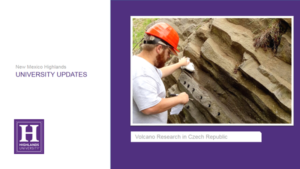
- Monday was a busy day. I also attended the Grand Opening of La Cocina Commercial Kitchen at Luna CC. This new commercial kitchen operation is a partnership between the Las Vegas EDC, Luna Community College, Siete Del Norte, and Highlands. HU had a kitchen we were not using, but the equipment was pretty decent. We donated the equipment to Luna. They operate a culinary arts program so there was a natural connection and on Monday, the new commercial kitchen was dedicated. Two businesses are already signed up to use the kitchen to produce food products and hopefully, more are on the way. A number of these commercial kitchen operations are functioning around the state (I think the oldest one is in Taos) and they have been quite successful. I believe that Taos Mountain Energy Bars were first made in the Taos commercial kitchen and today, they are sold in 48 states. A photo from the event at Luna:
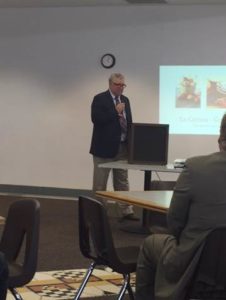
- If you drive by the football field, you will see a huge mud hole. We are not starting a mud volleyball team. As I imagine everyone knows, we received a major gift to replace the turf and is so often the case when any type of major renovation project begins, we found some issues we had not anticipated. The turf will be replaced the proper way using the proper techniques, but that means we will not play our first several soccer and football games there. AD Clifford has been working hard to make the arrangements to hold the contests elsewhere, but we are very hopeful things will be done by Homecoming. Speaking of football, Bob Clifford, Coach Fine, and I recently visited with Cam Cameron, former coach of numerous Division I and pro football teams including the Miami Dolphins, the San Diego Chargers, and others. Mr. Cameron’s son will play for the Cowboys this fall.
- On Tuesday, I greeted members of the Water and Natural Resources Committee. This group, chaired by Senator Joseph Cervantes, heard about some of the good things we are doing at HU as well as some of the challenges we face. The committee thanked HU for the warm hospitality they experienced while on our campus.
- The leadership team met on Tuesday and we had a good discussion regarding women in leadership roles. Is it easier for women to assume those roles now? Harder? How does all that play out at Highlands? We read this piece from Fortune Magazine: http://fortune.com/2015/03/26/the-trait-that-makes-women-great-leaders/. I really appreciated everyone’s candor at the meeting. We also met with Ms. Annette Velarde from the City of Las Vegas. She will be meeting with the team on a routine basis to more powerfully coordinate various activities between the city and the campus.
- I had a nice note from Dr. Dick Greene who is a Jefferson Science Fellow attached to USAID. Dick said he was involved in numerous activities both here in the US and around the world. He characterized his work as a “blitzkrieg” of interesting and meaningful projects. I know he is spreading the good word about HU during his time in Washington.
- This summer has seen a number of HU faculty members publish important books. I am aware of two…there may be more. Our good colleague Dr. Orit Tamir just published From Classic to Contemporary: Readings in Applied Sociocultural Anthropology and PJ Sedillo recently published Solidarity Through Pride, which has attracted positive attention in the region and nation. The jackets of these books:
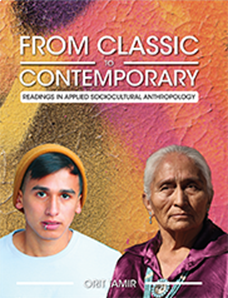

I have worked at numerous institutions where a 4/4 teaching load is the standard so I am well aware of how difficult it is to do a good job with that kind of teaching load and yet…someway and somehow…fulfill the scholarly expectations of an active academic life. It is very tough to do and I recognize that. I thank these two colleagues (and all others) who work so hard to achieve high levels of performance in all areas of the academy. I often think of something one my mentors at the University of Arizona said to me. The essence of what he said was, “Sam, you’ll come across some people who complain there is no time to do scholarly work. I hear that here at the UA where some professors teach one or two classes each term. Others don’t complain and use that time to actually do the work. If you want a good career, align yourself with the latter group.” This was from the late Sidney Bijou—noted psychologist, contemporary of B.F. Skinner, and truly one of the fathers of behavior therapy for children. Dr. Bijou passed away a few years ago at the age of 100. He gave me some very good advice. Over my career I’ve thought quite a bit about the important variables predicting high performance, particularly in the scholarly area. As a new academic, I pretty much assumed that it was all about time—the more time one had to devote to scholarly work—more work was produced. And, I do think that time is a very important factor. I once held a faculty job where my teaching load was oneone-semester hour class per term. That’s it. I had lots and lots of time to do research, grants, etc. and of course, I was expected to do that at a high level—it was my basic job. So, time matters and matters a great deal. But, that one one-semester hour teaching load is a real outlier in higher education. Most of the time, I and my colleagues taught a 3/3, a 4/4, or even heavier load. And yet—some of my colleagues teaching those loads really produced good scholarship and a substantial amount of it. How did they do that? Everyone finds their own path in all this, but the two variables that seem really critical to me are: (1) really hard work and consistent high effort and (2) a tendency to avoid activities and colleagues who are negative and kind of suck the life out of you. The first variable makes total sense to me. Not everyone works equally hard for all kinds of reasons. I certainly have not devoted the same level of effort to my work across my faculty career. When my kids were little, when I had big extended family responsibilities, when I was not healthy, when I was struggling with some decision—like most people, I did my job, but not at my highest level. But I can’t deny that hard work—high effort—results in good outcomes. Scholarly outcomes or otherwise. The second variable is more interesting to me. I vividly recall a colleague during my tenure at Murray State University—a very nice regional comprehensive in Kentucky. He was friendly, at least at a superficial level, but a little aloof. He came in every day and taught his classes and he was known as a good teacher. Then, he basically squirreled himself away in his office for most of the day and worked. He did his share of “service”, but no more than his share. Joining the BS session around the water cooler (that dates me, no?). Nope. He wasn’t there very much of the time at all. Like most departments, we had a few surly colleagues who were always complaining about something. He avoided them like the plague. He was nice enough (good morning Dr. XXXXXXXX), but nothing extra. As the new guy, I initially thought he was a little off putting. A little cold. Maybe not all that collegial. But then I understood that he was a top performer there and indeed, a person with a pretty decent national reputation. He was so darn busy doing his work, he had no time for distractions and absolutely no time for people who were negative and brought him down. I have no idea if my little theory is right, but that’s my experience. High performers, particularly in the scholarly domain, work really really hard and are very careful about the colleagues they spend much time with. My two cents. I am sure others have other ideas and I’d be glad to discuss them if you’d like,
- We are very close to announcing the lineup of performers we’ll have on campus this year. These performances are supported by the student-approved Campus Life fee. This year, we’ll have some well-known comedians during the fall term, a country performer in the spring, a touring group of women mariachis, an illusionist, a ballet, and others. We’re looking for a mix of male and female performers, performers from various cultural and ethnic groups, and a mix of high and popular culture events. The Office of Outdoor Recreation will be purchasing some golf equipment and we’ll offer lessons out at the course. We hope to set up a VR experience in the SUB and of course, we’ll offer the ski, hiking, and other excursions we did last year…all at no cost to our students after they pay the modest Campus Life fee. Well done to Dr. Kim Blea and her team for getting all this done. There are a lot of moving parts and it is not easy. As I’ve previously mentioned—providing fun and healthy opportunities for social activities on and away from campus is strongly correlated with student retention and provides great opportunities for students to meet new friends, make new contacts, and in some cases, make HU memories that will last a lifetime. Boulder, CO (home of UC-Boulder) was recently named the #1 college town in America. The article touting their high ranking went on to state, “ Boulder provides a vast array of outdoor recreational activities for their active student body. Students can literally get up early to ski (21 miles away), do a mountain biking trip (a few miles away), or take a memorable hike (right at the campus doorstep) and still get back in time for afternoon classes.” Flagstaff, AZ also ranked high in top college towns for the same reasons—easy access to outdoor activities including skiing, climbing, hiking, and others. Couldn’t we just about make those same claims here? Why don’t we?
- The books are now closed on the 2016-2017 academic year and I recently received a report from our Advancement Office regarding last year’s performance compared to recent years. In Fiscal Year 2015, for example, we brought in a total of $626,453 (restricted and unrestricted). In Fiscal Year 2016 (the beginning of the reengineer of Advancement), we brought in $1,473,468. This past Fiscal Year, we brought in $1,914,826. My colleagues—that is good performance. All credit is due to Vice President Law and her excellent team. Well done to all of them and we deserve to sincerely thank them for their high efforts. Much is also owed to our wonderful Foundation Board. A recent photo of the Board including emeritus members. Not sure why my jacket is white. I look like a dentist or maybe someone who sells makeup at a department store:
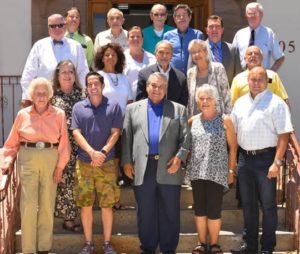
- On Wednesday we met some folks from the architectural firm who will be working on the renovation of the Rodgers Building. Everyone around the table was fully committed to (1) preserving the important historical features of the building, (2) making it a warm and welcoming “front door” for the campus, (3) doing the project in the most environmentally responsible way possible, and (4) most critically—finishing it on time and on budget. More on this as things evolve.
- I am very pleased to announce that on Mondays, Wednesdays, and Fridays members of the Las Vegas community (really, anyone) will be able to purchase a $5 lunch at our dining facility. The program will start this fall. We did five dollar lunches last year , but only one day per week. This expands the program considerably. Five dollars for all you care to eat—grilled selections (burgers, other sandwiches), pizza, salad bar, stir fry options, veggie selections, drinks, dessert, and more—all for five dollars on Monday, Wednesday, and Friday. Surely there is not a better lunch deal in town. Here at HU, we take the role of community partner seriously and this is merely the most recent manifestation of our commitment. As you might imagine, the margins on a five dollars all-you-can-eat-lunch are thin and I appreciate our new food provider (Sodexo) working with us on this important community program.
- On Thursday I met a representative of the local Citizen’s Committee for Historic Preservation. He asked that HU partner with his group to sponsor a workshop on the work of S. Omar Barker who was apparently a very well-known HU alumnus and (perhaps, not sure) a faculty member as well. He was well known for his cowboy poetry and novels. He was also a trombone player in Doc Patterson’s Cowboy Band, a forest ranger, a soldier, etc. I did a little Google search and sure enough, he was a pretty prolific and quite popular writer in his day. I’ll do a welcome at the meeting, which will be held on our campus on September 2. From what I learned online, he was well known for writing his name with the “S” on its side noting he was a “lazy S” O B (his initials). Pretty clever. A photo of S. O. B. (without the lazy S):

- Later Thursday, I drove to the HEC to attend the Santa Fe Center Fall 2017 Student Orientation. A large group of students attended and heard presentations from Dr. Kempner (the HLC), Ms. Ortiz-Gallegos (Registrar’s), Ms. Susan Chavez (Financial Aid) Ms. Paula Escudero (Business Office), Ms. Latasha Burbank (HU Cares), and other sessions focusing on the library, IT, D2L, and others. I very much appreciated the broad participation by administrators, faculty, and staff in this effort to make certain our Center students feel well informed and welcomed. A photo from last night’s event:
